Preprint
Article
Spatial Analysis of Middle-Mile Transport for Advanced Air Mobility: A Case Study of Rural North Dakota
Altmetrics
Downloads
53
Views
28
Comments
0
A peer-reviewed article of this preprint also exists.
This version is not peer-reviewed
Submitted:
11 September 2024
Posted:
12 September 2024
You are already at the latest version
Alerts
Abstract
Integrating advanced air mobility (AAM) into the logistics of high-value electronic commodities can enhance efficiency and promote sustainability. The objective of this study is to optimize the logistics network for high-value electronics by integrating AAM solutions, specifically using heavy-lift cargo drones for middle-mile transport and using the mostly rural and small urban U.S. state of North Dakota as a case study. The analysis utilized geographic information system (GIS) and spatial optimization models to strategically assign underutilized airports as multimodal freight hubs to facilitate the shift from long-haul trucks to middle-mile air transport. Key findings demonstrate that electronics, because of their high value-to-weight ratio, are ideally suited for air transport. Comparative analysis shows that transport by drones can reduce the average cost per ton by up to 60% compared to traditional trucking. Optimization results indicate that a small number of strategically placed logistical hubs can reduce average travel distances by more than 13% for last-mile deliveries. Cost analyses demonstrate the viability of drones for middle-mile transport, especially on lower-volume rural routes, highlighting their efficiency and flexibility. The study emphasizes the importance of utilizing existing infrastructure to optimize the logistics network. By replacing truck traffic with drones, AAM can mitigate road congestion, reduce emissions, and extend infrastructure lifespan. These insights have critical implications for supply chain managers, shippers, urban planners, and policymakers, providing a decision support system and a roadmap for integrating AAM into logistics strategies.
Keywords:
Subject: Social Sciences - Transportation
1. Introduction
Electronics are invaluable in today’s world, forming the backbone of modern society. People globally rely on electronic devices, such as smartphones and laptops, for both personal use and work, for a myriad of essential daily activities such as communication, scheduling, navigation, health monitoring, financial transactions, and entertainment. The world’s four largest companies by market capitalization (Microsoft, Apple, NVIDIA, Alphabet/Google) thrive because of the high demand for electronics. In the era of artificial intelligence (AI), access to electronic devices has become even more critical, further emphasizing their significance to society.
According to analysis of data from the U.S. Department of Transportation (USDOT) Freight Analysis Framework (FAF), electronics consistently rank as a top commodity by value/weight transported by air [1]. The FAF defines the commodity category of electronics to include items like consumer electronics (e.g., smartphones, laptops, tablets, office equipment, appliances), electronic components (e.g., semiconductors, batteries), and industrial electronics (e.g., machinery control systems, generators, transformers). Hence, the potential of advanced air mobility (AAM) to transform the logistics of electronics transport highlights its strategic importance. While trucks transport most electronics by weight, their high value-to-weight ratio makes them ideal for air transport. This duality offers a significant opportunity for AAM to reduce truck traffic by shifting electronics transportation to air. Reliance on trucks causes congestion, environmental degradation, and increased infrastructure wear. Hence, reducing truck traffic is vital in mitigating congestion, promoting environmental sustainability, and extending the lifespan of surface transportation infrastructure. Roadway construction and traffic bottlenecks can jeopardize same-day delivery schemes, which are becoming a more crucial need in e-commerce [2].
Although shippers use air transport for some electronics, the systematic use of AAM to achieve further shift in transport from ground to air remains underexplored. While existing studies highlight the benefits of air transport for high-value goods, they often overlook comprehensive integration strategies for AAM within the electronics supply chain. The objective of this study is to bridge this gap by proposing a novel multimodal logistics framework, evaluating the potential of AAM to transform electronics transport logistics, and focusing on efficiency, cost, and sustainability.
This paper presents a vision for AAM deployment, using a case study that blends the utility of autonomous trucks (ATs) and drones to serve urban and rural communities. This vision includes the establishment of multimodal truck transfer hubs (TTHs) to facilitate the transfer of freight between long-haul ATs and heavy-lift cargo drones. As illustrated in Figure 1, ATs or regular trucks that arrive from other states would deliver freight to a designated TTH. Heavy-lift cargo drones would then distribute freight to smaller multimodal freight hubs (MFHs) for last-mile deliveries to the nearest population centers. Regular or electrified vans or drones can complete the last-mile distribution. To achieve this vision, this research proposes repurposing and expanding a certain number of airports in the target state to serve as sites to develop TTHs and MFHs. Studies suggest that many small U.S. airports are underutilized [3], hence AAM deployments can leverage these existing facilities.
The unique contribution of this paper lies in its development and application of a novel GIS-based optimization model specifically tailored for integrating AAM solutions into middle-mile logistics for high-value electronics. Unlike existing studies that primarily focus on last-mile delivery or hybrid truck-drone systems, this research addresses the underexplored middle-mile segment. By strategically selecting MFHs and TTH locations through a distance minimization optimization process, the study aims to significantly reduce travel distances, alleviate congestion, lower emissions, and extend infrastructure lifespan. The optimization process identifies a point of diminishing returns as a function of the number of MFHs added. Identifying TTHs involves selecting a subset of the identified MFHs as transfer points for long-haul freight entering the state. These TTHs will be strategically located away from busy international airports to avoid additional traffic and placed near state entry points on Interstate highways to minimize heavy truck movements within the state [1]. The freight distribution from TTHs to MFHs will be in proportion to the respective MFH population catchments.
The authors selected the state of North Dakota for a case study of implementing the vision for several reasons. North Dakota is one of the most sparsely populated states in the nation [4], making it ideal for the testing and deployment of AAM with AT integration. North Dakota is also the only state in the nation approved by the federal government for drone operations beyond human visual observation [5]. North Dakota also has several large population centers such as Fargo and Bismarck-Mandan with urban characteristics, enabling a comparison of the logistical differences between trucks and drones in the same state. The empirical case study in North Dakota demonstrates the practical implementation and scalability of the proposed model, offering actionable insights for broader application in diverse geographical contexts.
The organization of the rest of this paper is as follows: Section 2 reviews the literature on AAM and the utility of drones in freight transportation. Section 3 describes the details of the methodological workflow developed. Section 4 presents the analytical results, and Section 5 discusses implications for stakeholders such as supply chain managers, shippers, urban planners, and policymakers. Section 6 concludes the research and suggests directions for future work.
2. Literature Review
The next two subsections describe the results of the literature review on AAM and the utility of drones in freight transportation.
2.1. Advanced Air Mobility
AAM encompasses the use of drones, specifically electric or hybrid-electric vertical takeoff and landing (eVTOL) and short takeoff and landing (STOL) aircraft, to provide innovative transportation solutions for goods [6] and people [7]. eVTOL aircraft operate like helicopters but are quieter and do not require runways [8]. STOL aircraft require a much shorter runway than a traditional winged aircraft and typically fly further than an eVTOL aircraft. These new types of air transportation promise significant cost advantages, particularly through autonomous operation [9] in beyond visual line of sight (BVLOS) conditions [10]. Key motivations to deploy AAM are to reduce ground traffic congestion, travel times, pollutive emissions, and the strain on public transportation [11]. Dulia et al. (2021) discussed the environmental benefits of drone logistics, emphasizing reductions in emissions and energy consumption [12].
Current drones have limited capabilities, with most commercial deployments using small vehicles carrying tens of kilograms over tens of kilometers [13]. However, the industry expects that emerging heavy-lift cargo drones will transport hundreds of kilograms over hundreds of kilometers [14]. A survey by Akash et al. (2021) found that many of the emerging passenger eVTOL aircraft will carry five persons weighing a total of 450 kilograms (1000 pounds) for a distance of 500 kilometers (310 miles) [15]. Some of these manufacturers have proposed using the same aircraft to transport the equivalent weight in cargo. De Reyes (2020) reported on the development of a specialized drone that can transport almost 2,500 kg (5,500 pounds) of cargo in vertical takeoff mode and as much as 4,500 kg (10,000 pounds) in short takeoff mode [16].
Despite their potential, AAM technologies are in the early stages of development, with commercial deployments anticipated after 2030 [10]. There are many barriers to scaling AAM deployments. Challenges include attaining the safe operations of aircraft in varied weather conditions [17], battery performance and safety in all-season operations [18], adequate wireless coverage in congested cities and disconnected rural communities [19], and seamless integration into existing airport facilities [20]. Additionally, the regulatory environment remains a significant barrier, with ongoing efforts required to establish frameworks that support the safe and secure operation of drones in commercial logistics [9]. Sah et al. (2021) highlighted potential security and privacy threats associated with drone logistics [21]. Their findings emphasized the necessity for robust cybersecurity measures and regulatory oversight to mitigate risks such as data breaches, unauthorized access, and surveillance concerns.
Guo et al. (2024) explored the societal impacts of AAM, highlighting both opportunities and challenges in public acceptance and regulatory compliance [6]. They concluded that while AAM offers transformative benefits in transportation efficiency and accessibility, public acceptance hinges on addressing safety, noise, and environmental concerns. Janotta and Hogreve (2024) investigated the societal impacts of Urban Air Mobility (UAM), emphasizing the need for a balanced approach to its implementation [7]. Their study identified that successful UAM integration requires addressing issues of urban infrastructure adaptation, public trust, and equitable access.
2.2. Drones in Freight Transport
Although some market research reports have acknowledged the potential for AAM to revolutionize freight transport, scholarly literature on the topic is scarce. For instance, a Boolean keyword search of (“advanced air mobility” OR “urban air mobility”) AND (“freight” OR “cargo”) on either of the popular Web of Science (WOS) or Scopus databases resulted in only 46 journal articles. A search for the term “cargo drone” resulted in only 8 and 17 journal articles on WOS and Scopus, respectively. The topics covered in those articles include various aspects of aircraft design, operations, regulations, public acceptance, barriers to deployment, and demand analysis. Hence, the gap in the literature is that only a few studies considered the types of cargo commodities that could be amenable for middle-mile transport by AAM modes. For instance, Bridgelall (2024) discussed a strategic hub placement to reduce urban congestion near international airports and ports [1].
Retail giants like Amazon and Walmart have already demonstrated the capability of drones for handling frequent deliveries of small packages [13], suggesting a growing acceptance and feasibility of cargo drone applications. Long et al. (2023) emphasized the need for substantial market demand to justify investments in AAM infrastructure and technology [22]. Studies have highlighted the potential of drones to improve the efficiency of last-mile deliveries by reducing transport times and costs compared with traditional ground transport [23]. Zhao et al. (2024) demonstrated that drones could significantly enhance delivery efficiency, particularly in urban settings [24]. Ioannidis et al. (2023) presented a case study of five Greek cities that utilized a 5-kilogram payload cargo drone, leading to more than 89% cost savings compared to trucks [25]. Naor et al. (2024) conducted a case study of delivering refrigerated medical cargo between warehouses and hospitals in Israel and found that powering drones with hydrogen cells instead of standard Lithium-based cells can minimize downtime due to charging [26]. Others suggested that the industry can further optimize drone-based logistics by developing aircraft that can adapt to different cargo geometry and mass [27], and specialized containers such as refrigerated pods that can attach to drones [28]. While these studies focused on last-mile deliveries, there is a lack of research on the potential for drones to transform middle-mile logistics.
Overall, while the existing literature has explored various aspects of Advanced Air Mobility (AAM) and its applications in logistics, significant gaps remain, particularly in the integration of AAM within middle-mile transport and the strategic use of underutilized airport infrastructure as multimodal freight hubs. Previous studies have focused on last-mile delivery, aircraft design, and public acceptance, often overlooking the critical middle-mile segment and the potential for optimizing logistics networks through AAM. Additionally, there is a lack of comprehensive frameworks that address the operational and infrastructural challenges of implementing AAM in diverse geographical contexts. This study addresses these gaps by proposing a novel optimization model that not only enhances the efficiency of logistics networks but also leverages existing infrastructure to support sustainable and scalable AAM integration. The findings of this research are therefore essential for advancing both theoretical understanding and practical applications in the evolving field of logistics.
3. Methodology
This research employs spatial optimization via GIS to estimate the number of MFHs for reducing the average travel distance for last-mile transport. The methodology is generalizable for application to any location. This approach offers distinct advantages over traditional optimization methods by incorporating geographic constraints, population distribution, and infrastructure availability directly into the analysis. The integration of diverse data layers—such as road networks, airport locations, and population centers—ensures that the selected hubs are not only theoretically optimal but also practically feasible in real-world applications. This GIS-based methodology provides a more precise and context-specific solution, enhancing the overall efficiency and sustainability of the logistics network, and addressing the complex spatial interactions inherent in middle-mile transport. The subsections that follow demonstrate a U.S. application of the methodology based on the local data sources described.
3.1. Data Sources
Table 1 summarizes the data sources employed in the ND case study. The Highway Performance Monitoring System (HPMS) contained shapefile data for all U.S. roadways [29]. The airport database contained points data on all official U.S. operational aerodromes [30]. The GIS workflow extracted 89 public use airports in ND for MFH site selection. The places dataset contained polygon shapefiles representing all populated places registered by the U.S. Census Bureau [31].
The commodity analysis utilized version 5.6 of the United States Department of Transportation, Bureau of Transportation Statistics (BTS), freight analysis framework (FAF) data to extract the forecasted weight and value of freight movements in 2030 [32].
3.2. Commodity Rank
Selecting the year 2030 for the scenario analysis aligns with the timeframe expected for AAM deployments [10]. In analyzing the FAF dataset, Figure 2 shows the commodity rank of electronics forecasted to arrive via air across different U.S. states. The commodity rank analysis establishes a broader context for identifying the relevance and priority of high-value electronics within the logistics framework. This analysis ensures that the focus on high-value electronics is well-grounded and highlights its significance among various commodities.
Figure 2a lists the states in descending order of the value/weight ratio of electronics expected. The heatmap color scheme shows darker red representing high values and darker blue representing low values. The key observations are that Idaho (ID) has the highest value/weight ratio, followed by Vermont (VT) and North Dakota (ND). States such as Colorado (CO) and Tennessee (TN) also have fairly high value/weight ratios. On the lower end, states like Iowa (IA), Missouri (MO), Hawaii (HI), and West Virginia (WV) exhibit the lowest value/weight ratios.
Figure 2b provides another view of the analysis results by listing the states in descending order that electronics rank by weight among all commodity categories forecasted to arrive via air. Values closer to 1 (higher rank) indicate that electronics have a higher value/weight ratio than any other commodities forecasted to arrive by air. The heatmap color scheme uses darker red to represent lower rank (higher values) and lighter blue to represent higher rank. The key observations are that North Dakota is among only three U.S. states where the value/weight ratio of electronics will rank highest among all commodities entering the state by air. This finding further justifies selecting North Dakota for this case study. The value/weight ratio of electronics ranks lowest among commodities forecasted to enter states such as West Virginia (WV), Wisconsin (WI), and Connecticut (CT).
States with higher value/weight ratios (ID, VT, ND) forecasted to enter may benefit more from shifting electronics transport to air, emphasizing the potential impact of AAM in these locations. Conversely, states with lower value/weight ratios forecasted to enter might continue relying more on traditional truck transport. This information is critical for supply chain managers, shippers, urban planners, and policymakers in making informed decisions about transportation strategies and infrastructure investments.
Figure 3 illustrates the value per kiloton of various commodities forecasted to enter North Dakota by truck and air in the year 2030. The figure lists the commodities vertically, while the horizontal axis represents the value in million dollars per kiloton. The blue and orange bars represent the value per kiloton transported by truck and air, respectively. The figure ranks the commodities by the value per kiloton transported by trucks, with tobacco products representing the highest value at the bottom. The key observation is that electronics have the highest value per kiloton when transported by air, significantly higher than when transported by truck. As expected, commodities with no significant air transport include gravel, waste/scrap, nonmetallic materials, coal, and logs. Trucks typically transport these, reflecting their low value-to-weight ratios which make air transport economically unfeasible. These observations support the proposal that AAM could significantly impact the transport of electronics by shifting more of this high-value commodity to air transport, reducing truck traffic and enhancing efficiency and sustainability. Conversely, shippers transport low-value, high-weight commodities by truck, indicating the potential to use autonomous trucks in these sectors, which would be scope for future studies.
Figure 4 compares the total weight (blue bars) and value (orange line) of electronics forecasted to enter North Dakota in 2030 by trucks, multiple modes including trucks, rail, air, and other modes. Figure 4a shows the value in billion dollars ($B) for each mode. Figure 4b shows the value/weight ratio in million dollars per kiloton. The key observation is that truck transport will dominate the weight of electronics transported, with more than 400 thousand tons. For perspective, a typical semi-trailer truckload (big rig) can haul 20 tons [1]. Hence this weight represents the potential for AAM to remove more than 400,000/20 = 20,000 semi-trailer truckloads annually from North Dakota roads. Another observation is that despite a significantly lower weight (less than 1000 tons) transported by air (not visible on the chart), the value is notably higher, close to $500 million, highlighting the current preference of standard air transport for exceedingly high value-to-weight ratio commodities. Together, these charts highlight the enormous potential for shifting the transport of electronics from other modes to air, particularly if the cost of using AAM modes can be lower.
3.3. Analytical Workflow
The workflow began by establishing the GIS model for ND population centers, airports, and road networks. Figure 5 illustrates the analytical workflow, which consists of two main parts—the GIS procedures on the left, and the optimization procedures on the right. The GIS workflow utilized version 3.34.6 of the open-source QGIS software to implement the geographic model [34]. The GIS connected point representations of populated places and airports to the road network so that the origin-destination (OD) matrix will be complete and accurate. The “Places” procedure extracted polygons representing all the populated areas in North Dakota, and the “Centroids” procedure calculated a centroid for each polygon to represent the population centers.
The “Roads” procedure extracted ND road network representations from the HPMS database. Subsequently, the “Dissolve” procedure combined network segments with the same “ROUTE_ID” to reduce the computational burden. The “Filter” procedure removed local roads from the network because most of them were unpaved or not suited for truck routes. The “Snap Nodes” procedure moved the points representations of population centers and airports to their closest point on the filtered road network, enabling accessibility for route distance calculations. The “OD Matrices” procedure calculated network distances between all points representing populated places and airports, and between all points representing airports only. The distance calculation utilized a step tolerance along the network to accumulate the length of the shortest paths between pairs of points. The lower the distance tolerance, the more accurately the algorithm followed paths along the network, but also the more computationally intensive it is. Too small of a step tolerance resulted in some unreachable points on the network. These unreachable points occurred when the snapping procedure placed points in network islands caused by the removal of local roads connecting them. Hence, the “missing links” test iteratively identified isolated points to locate the gaps causing network discontinuity. Measuring the gap associated with any isolated points informed the amount to increase the tolerance so that the algorithm can jump over discontinuities before recomputing the OD matrices.
After achieving full network connection for all points, the optimization proceeded. The input to the optimization was the OD matrix between populated places and airports. The optimization procedure iteratively determined the assignment of populated places to N airports so as to minimize the total network distance. The method of distance optimization used linear programming with binary decision variables. The solver for the linear programming problem was from the PuLP library (version 2.9) of Python [35]. The formulation for the optimization was as follows:
I: set of populated places, indexed by i
J: set of airports, indexed by j
cij: total cost (road network distance) of assigning place i to airport j
xij: binary decision variable that equals 1 if the optimizer assigns place i to airport j, and 0 otherwise
Yj: binary variable that equals 1 if the optimizer assigns airport j to any location, and 0 otherwise.
Minimize:
Subject to:
and
and
The three equations that follow the label “Subject to:” are the constraints in the optimization problem. The first constraint ensured that the optimizer assigned each populated place to exactly one airport. The second constraint forced Yj to be set to 1 if the optimizer assigned airport j to any location. The final constraint ensured that the optimizer assigned exactly N airports. The user iterated the value of N for each optimization session to obtain a plot of the average minimized distances as a function of the number of airports N. The user then identified a point of diminishing returns in selecting N airports to locate MFHs.
Overall, the point of diminishing returns in total distance minimization guided the selection of MFH and TTH locations. Specifically, this optimization process automatically identified the subset of airport locations that would minimize the overall travel distance for logistics operations, considering factors such as existing infrastructure and potential demand. The author then selected the TTH from the pool of optimized MFH locations to further minimize the distance that long-haul trucks must travel within the state, ensuring that the logistics network is both efficient and cost-effective. The workflow then merged the optimized OD links for the N selected airports with the OD matrices. The merge procedure created “Null” entries for unmerged links based on the merge key, which the “Drop Nulls” procedure eliminated before displaying the final map.
The population catchment analysis involved identifying areas with high concentrations of potential users, ensuring that MFHs and TTHs are located to serve the maximum number of people efficiently. The “Population Catchment” procedure calculated the total population assigned to each airport, representing a relative demand for commodities at that MFH location. The FAF analysis used comprehensive freight data to understand and predict cargo movement patterns, providing a data-driven foundation for our network design. The “FAF Extraction” procedure extracted the weight and value of all electronics forecasted to arrive in North Dakota via trucks in 2030. The “FAF Analysis” procedure then calculated the distribution of those commodities by their origin state. Categorizing those into weight arriving from states east, west, and south of North Dakota informed identification of the commodity proportions expected at the Interstate entry points. Canada borders North Dakota to the north, so the analysis excluded imports from those locations to focus on the domestic movements. The workflow then assigned MFHs closest to those Interstate entry points to also serve as TTHs. This strategy aimed to minimize heavy truck movements within the state and also to avoid locations close to busy international airports within the state. Shippers can further synergize the distribution of electronics arriving via air at larger regional or international airports by transferring those freight to the nearest TTH.
The demand estimate process incorporated both historical data and predictive modeling to forecast future logistics needs, ensuring that the infrastructure is scalable and adaptable to changing demand patterns. This middle-mile distribution strategy utilized a population weighted demand (PWD) to determine the annual tons for transport to each MFH. The “Demand Estimate” procedure calculated the PWD as the product of the proportion of the population catchment by ground transport for each MFH and the total weight arriving at each TTH. The “Vehicle distributions” procedure compared the daily middle-mile transport required by trucks and drones from each TTH to the other MFHs based on their PWD. The “Costs” procedure estimated the cost of middle-mile transport by trucks and drones. The “Vehicles” procedure calculated the underutilization rates for middle-mile transport by trucks and drones, and the number of vehicles needed per route. Finally, the authors assessed the cost impacts and tradeoffs in using drones for middle-mile transport.
4. Results
The following subsections describe the results aligned with each part of the analytical workflow presented in the methodology section.
4.1. MFH Location Optimization
Figure 6 shows the solution to the optimization problem in selecting N of the public use airports in North Dakota based on minimizing the total distance to population centers for last-mile transport. The graph shows how increasing the number of airports will affect the average travel distance covered for last-mile deliveries. The blue circles represent the observed data points for the average travel distance corresponding to different numbers of airports. The black dotted line represents the fitted trend line for the data points, showing the relationship between the number of airports and the average travel distance. The following power-law model best described the trendline
with an R-squared value of 0.999, derived using the built-in Microsoft Excel feature. This high R-squared value suggests that the model accurately describes the relationship between the number of airports and the average travel distance. Hence, Figure 6 inherently performs a sensitivity analysis by illustrating how varying the number of MFH locations impacts the total travel distance. This helps identify the point of diminishing returns, where additional MFHs do not significantly reduce travel distance, indicating an optimal number of MFHs for cost-effectiveness.
Planners can utilize this simple model in tradeoff analysis to directly predict the average distance to population centers for a given number of MFH deployments, without executing the optimization model. The key observation from the optimization results is that the average travel distance decreases as the number of airports increases. Initially, the decrease was steep with a 13% reduction in average travel distance when the number of airports increased from 5 to 10. This significant reduction in average travel distance highlighted the efficiency gains from only a few strategic hub placements. Further increasing the number of airports from 10 to 15 resulted in only a 6% reduction in average travel distance, and less than 3% after around 20 airports. The substantial slowing down of average distance reduction after selecting 20 airports established it as the point of diminishing returns, setting the stage for a logistical analysis comparing the costs of using trucks and drones for middle-mile transport.
4.2. Origin State Distribution
Figure 7 shows the top ten origin states by weight of electronics forecasted to enter North Dakota by truck in 2030. The blue bars show the weight in kilotons and the orange line shows the value in million dollars. The bar shown for ND is for interstate transport, representing pickup and deliveries within the state. The origin states of Kansas (KS) and Illinois (IL) will dominate by the weight entering North Dakota. Table 2 summarizes the total weight and value forecasted to arrive from all U.S. states south, east, and west of North Dakota. The table also lists the Interstate routes that trucks are expected to utilize when entering the state.
4.3. TTH Site Selection
Figure 8 presents a map of ND that highlights the 20 airports proposed to locate MFHs, major truck routes, and the minimum distance routes that connect population centers to each MFH. The map shows population centers as colored circles, with the darker colors representing larger populations. The blue stars indicate the locations of the proposed MFHs. The map annotates the Interstate entry points for I-94 and I-29. These are major transportation corridors that run east/west and north/south across the state, connecting several key hubs. The light-colored lines represent the main arterials that trucks would take, preferring them over local roads which the GIS network filter eliminated. The dark colored lies are the optimized shortest paths from the populated places to their respective MFH. The green colored areas are Native American community locations (Turtle Mountain, Fort Berthold, Spirit Lake, Standing Rock, Lake Traverse), highlighting the inclusivity of the solution.
This analysis selected an MFH at the Richardton airport in the western part of the state, and an MFH at the West Fargo airport to serve as TTHs. These facilities will be located closest to the Interstate entry points and away from the busy international airports. The TTHs must support large truckload transfers to drones, in addition to supporting smaller trucks or vans for last-mile deliveries. Those large trucks can include autonomous long-haul freight movers that have easy access to TTHs from an Interstate route, avoiding narrower arterials and local roads.
4.4. Demand Estimate
Table 3 summarizes the annual weight and value of electronics estimated to arrive at the two selected TTHs based on the expected Interstate entry points from the origin states. The forecasted weight of electronics arriving from states east and south of ND will be at least 38 times more than the weight of electronics arriving from states in the west. These will arrive at the proposed TTH in West Fargo for further distribution via either last-mile modes to its population catchment or via middle-mile modes to the other proposed MFHs across the state.
Table 4 summarizes the variables used in the remainder of the analysis and their derivations as indicated by the equations. Table 5 lists the 20 proposed MFHs at the airport locations indicated. The list is in ranked order of their population catchment by truck routes (PCT), with the highest population at the top. A key observation is that the largest population catchments are in the eastern part of the state as well as from towns that are closer to the two main Interstate highways. The areas around the city of Fargo and the capital of Bismarck-Mandan have urban characteristics whereas the other locations are rural, dedicated to mostly farming or energy production.
The TMA and DMA columns of Table 5 list the average truck and drone miles, respectively, when traveling to the population centers assigned to the proposed MFH. The average TMA and DMA across all MFH locations are 28.3 and 22.6 miles, respectively. The standard deviations are less than 4.5 miles. The average DMA is approximately 20% less than the average TMA because drones will take more direct geodesic flight paths to the population centers to maximize efficiency, whereas trucks must take the circuitous paths constrained by roads. The low standard deviation of the average distances across MFHs highlights the consistent accessibility of populated places in their catchment. This suggests that the selected locations are well within the last-mile transport range of electrified package delivery vans or drones. For instance, a typical battery electric cargo van has a driving range of more than 100 miles [36].
The population weighted demand (PWD) in annual tons at each MFH is based on the PCT proportion (PPT) of the total population. The PWD listed represents the weight that last-mile transport will distribute from those proposed MFH locations to their population center catchments. The annual tons shown for the two proposed TTHs (TTH1 and TTH2) are based on the PPT of the total weight that middle-mile transport will distribute from those two locations (Table 3) to the MFH listed in each row. For example, the weight shown for TTH1 is the annual tonnage that middle-mile transport will distribute from TTH1 to the MFHs in each row. The only exception is that the weight arriving at a TTH for distribution to its associated population centers will be via last-mile transport.
4.5. Vehicle Distributions
Table 6 and Table 7 list the number of truckloads (TLD) and drone loads (DLD) that middle-mile transport will deliver from TTH1 and TTH2, respectively, to the other MFH locations. The truckload calculations are based on utilizing a single-unit class 6 box truck with a 7000-pound (3.5-ton) payload capacity because those are suitable for transporting high-value cargo 300-400 miles [37]. The drone load calculations are based on emerging heavy-lift cargo drones capable of transporting 1000-pounds (0.5 ton) for more than 400 miles [13]. Because of the large variety of available cargo drones, the analysis can optimize the assignment of drone types based on the required transport distance and payload capacity for each route. However, the analysis utilized a fixed drone payload capacity to establish a baseline comparison with fixed-capacity trucks.
4.6. Cost Comparisons
The truck cost used in the analysis was the most recently reported average cost of $2.34 per mile for a common LTL box truck, reported by the American Transportation Research Institute [33]. For comparative analysis, the drone cost per mile (DCM) for the total logistical cost to be the same as using trucks would be
where J is the set of MFH indexed by j. The result was that DCM must cost less than $1.18 per mile to achieve the same total logistical cost of using trucks.
Table 8 and Table 9 summarizes the forecasted daily costs for truck and drone transport from TTH1 and TTH2, respectively. The N/A entries in the tables indicate that transport from those TTHs to their associated populated places will be via last-mile rather than middle-mile transport.
Figure 9 plots the forecasted daily transport costs from these facilities. The subplots compare the middle-mile transport costs from each TTH to the different MFHs. The horizontal axis lists the various MFH locations, and the vertical axis represents the daily transport costs for electronics. The blue and orange lines represent the transport costs by truck and drone, respectively. The gray bars and the right axis represent the PWD in annual tons. The order of the airports on the chart is by PWD rank. The key observation is that middle-mile transport costs by truck will be comparable to those of drones for the TTH at West Fargo that will process higher volumes of electronics. Without modulating the cargo drone payload capacity to maximize utilization, the average total cost for drones at this TTH will be approximately 8% higher than for trucks. Conversely, the cost for middle-mile transport by drones will be approximately 57% lower for the TTH at Richardton because the volume it will process will be much lower.
Figure 10 consists of two subplots, showing the cost per ton for transporting electronics from the two TTH. With this metric, the cost per ton by drones is consistently lower than using trucks at the Richardton TTH that will process significantly less volume of electronics than the West Fargo TTH. The average cost per ton using drones will be approximately 9% and 60% lower at the TTHs in West Fargo and Richardton, respectively.
4.7. Vehicle Utilization
Figure 11 consists of two subplots that present the underutilization rates for fixed payload trucks and drones from the two TTH at West Fargo and Richardton.
The key observation is that the underutilization rates for drones will remain consistently lower than for trucks across all MFHs at both the West Fargo and Richardton TTHs. For both modes, the underutilization rates will increase more drastically for the Richardton TTH that will process much less volume of electronics. The average underutilization rate for drones is approximately 9% and 40% less than for trucks at the West Fargo and Richardton TTHs, respectively. This finding highlights the efficiency of using drones to transport freight to lower demand centers because they can carry smaller loads more frequently. Drones are available for a wider range to transport capacity for loads of less than half of a ton [27], so they would be more suitable for deployment at TTHs that will process less volume.
5. Discussions
The analysis provides a comprehensive examination of the potential impacts of AAM on the transportation of high-value electronic commodities, using North Dakota as a case study. The findings highlight several key insights into how AAM can transform logistics, reduce truck traffic, and enhance sustainability in the transportation sector.
5.1. Commodity Rank
Figure 2a and Figure 2b illustrates the value-to-weight ratio and commodity rank of electronics arriving via air across different states. The data indicates that states such as Idaho, Vermont, North Dakota, and Colorado have the highest value-to-weight ratios, emphasizing the potential for AAM to significantly impact these regions by shifting electronic transport from trucks to air. This shift is particularly beneficial for high-value commodities, which are more economically viable for air transport. The findings suggest that states that import commodities with higher value-to-weight ratios could prioritize AAM integration to optimize logistics strategies, reduce congestion, and promote environmental sustainability.
5.2. Comparing Transport Modes
The comparative analysis of transport modes in North Dakota, as shown in Figure 3, reveals that electronics have a significantly higher value per kiloton when transported by air compared to trucks. This supports the notion that AAM can provide substantial economic benefits by facilitating the transport of high-value goods. The transition from trucks to air transport for these commodities will not only reduce road congestion but will also mitigate the environmental impact associated with heavy truck traffic.
5.3. Optimization of MFH
The optimization results presented in Figure 6 demonstrate the effectiveness of strategically establishing the number of MFHs to establish at existing airport facilities to achieve practical average travel distances for last-mile deliveries. The observed trend shows diminishing returns after approximately 20 airports, indicating an optimal number of MFHs for maximizing efficiency. This model can serve as a valuable tool for planners to balance infrastructure investments with operational efficiency, ensuring that AAM deployments are both cost-effective and beneficial to the overall transportation network.
5.4. Geographic Distribution
Figure 7 and Figure 8, along with Table 3, provide a detailed look at the geographic distribution of electronics arriving in North Dakota and the estimated demand at proposed TTHs. The data highlights the importance of strategically locating TTHs to optimize the flow of goods and reduce the need for long-haul truck movements within the state. Expanding underutilized airports to serve as MFHs and TTHs leverage existing infrastructure to enhance the efficiency of electronic goods transportation.
5.5. Cost Analysis
The cost analysis in Figure 9 and Figure 10 shows that drones offer competitive transport costs compared to trucks, especially for lower-volume routes processed at TTHs like Richardton. Furthermore, the underutilization rates illustrated in Figure 11 indicate that drones are more efficient for transporting freight to lower-demand centers due to their ability to carry smaller loads more frequently. This flexibility positions drones as an optimal solution for low-volume regions, thus enhancing the logistics network’s overall efficiency and sustainability.
5.6. Implications for Practice and Policy
The insights gained from this study have significant implications for various stakeholders, including supply chain managers, shippers, urban planners, and policymakers. The integration of AAM in the transport of electronics can lead to:
Reduced road congestion: By shifting a substantial portion of freight transport from trucks to the air, AAM can alleviate congestion on major highways, improving traffic flow and reducing wear on infrastructure.
Environmental benefits: The reduction in truck traffic translates to lower emissions and energy consumption, contributing to environmental sustainability goals.
Economic efficiency: The higher value-to-weight ratio of air-transported electronics suggests cost savings and increased efficiency, particularly for high-value goods.
Infrastructure optimization: Strategically located MFHs and TTHs leverage existing airport infrastructure, minimizing the need for new construction and maximizing the utility of underutilized facilities.
Overall, the strategic placement of MFHs and TTHs can optimize logistics operations, leveraging existing infrastructure to support the seamless transfer of goods from long-haul trucks to drones for middle-mile and last-mile deliveries. Additionally, the integration of autonomous trucks with AAM could further enhance logistics efficiency, offering a comprehensive solution for modern supply chain challenges.
5.7. Limitations
Despite the promising results, this study acknowledges some limitations. First, the optimization model relies on specific assumptions regarding infrastructure availability and operational conditions, which analysts may need to adjust for other geographies. Second, while the study focuses on the integration of AAM for middle-mile logistics, it does not extensively address last-mile delivery challenges, which are critical for the end-to-end efficiency of the logistics network.
5.8. Future Work
Although the methodology presented is adaptable for any location, future research should expand the analysis to include other high-value commodities and different geographic regions to explore nuances. As the scope of this study focused on the logistics of AAM, future analysis could focus on the regulatory frameworks required to facilitate widespread AAM adoption and address potential security and privacy concerns associated with drone logistics.
6. Conclusions
This study investigates the transformative potential of advanced air mobility (AAM) in the logistics of transporting high-value electronic commodities. The comprehensive analysis highlights several critical insights that emphasize the importance of integrating AAM into the existing transportation infrastructure. The findings demonstrate that electronics, due to their high value-to-weight ratio, are prime candidates for air transport. The comparative analysis of transport modes reveals significant economic benefits of air transport over traditional trucking for high-value goods. By shifting a substantial portion of electronics transport from trucks to air, AAM can reduce road congestion, cut emissions, and extend the lifespan of surface transportation infrastructure. Selecting the appropriate number of multimodal freight hubs (MFHs) and the strategic placement of truck transfer hubs (TTHs) emerge as crucial factors in enhancing the efficiency of the logistics network. The study identifies the number of hubs required to establish practical travel distances for last-mile deliveries, balancing infrastructure investments with operational efficiency. The cost analysis further supports the viability of drones for middle-mile transport, especially for lower-volume routes. The flexibility and efficiency of drones make them particularly suitable for regions with lower freight volumes, providing a cost-effective solution that complements traditional trucking. The geographic distribution and demand estimation highlights the importance of leveraging underutilized airports to serve as MFHs and TTHs. This approach leverages existing infrastructure, enhancing the overall efficiency of electronic goods transport while minimizing the need for new construction. For stakeholders, including supply chain managers, shippers, urban planners, and policymakers, the integration of AAM presents numerous benefits. These include reduced road congestion, environmental sustainability, economic efficiency, and optimized infrastructure use. Future research should investigate the integration of autonomous trucks, develop regulatory frameworks, and expand the analysis to other high-value commodities and diverse geographic regions.
Funding
This research received funding from the United States Department of Transportation, Center for Transformative Infrastructure Preservation and Sustainability (CTIPS), Funding Number 69A3552348308.
Data Availability Statement
This article includes the data presented in the study.
Conflicts of Interest
The author declares no conflicts of interest.
References
- Bridgelall, R. Locating Electrified Aircraft Service to Reduce Urban Congestion. Information 2024, 15, 186. [Google Scholar] [CrossRef]
- Straubinger, A.; Groot, H.L.d.; Verhoef, E.T. E-commerce, Delivery Drones and Their Impact on Cities. Transportation Research Part A: Policy and Practice 2023, 178, 103841. [Google Scholar] [CrossRef]
- Cox, J.; Harris, T.; Krah, K.; Morris, J.; Li, X.; Cary, S. Impacts of Regional Air Mobility and Electrified Aircraft on Airport Electricity Infrastructure and Demand; National Renewable Energy Laboratory: Washington, DC, USA, 2023. [Google Scholar]
- USCB. State Population Totals and Components of Change: 2020-2023. United States Department of Commerce. 18 December 2023. Available online: https://www.census.gov/data/tables/time-series/demo/popest/2020s-state-total.html (accessed on 7 January 2024).
- Vantis. FAA Grants Initial Approval Allowing BVLOS Drone Flights on North Dakota Drone System. 9 January 2023. Available online: https://www.vantisuas.com/news/article/faa-grants-initial-approval-allowing-bvlos-drone-flights-on-north-dakota-drone-system (accessed on 11 May 2024).
- Guo, J.; Chen, L.; Li, L.; Na, X.; Vlacic, L.; Wang, F.-Y. Advanced Air Mobility: An Innovation for Future Diversified Transportation and Society. IEEE Transactions on Intelligent Vehicles 2024, 9. [Google Scholar] [CrossRef]
- Janotta, F.; Hogreve, J. Ready for Take-off? The Dual Role of Affective and Cognitive Evaluations in the Adoption of Urban Air Mobility Services. Transportation Research Part A: Policy and Practice 2024, 185, 104122. [Google Scholar] [CrossRef]
- Bridgelall, R.; Askarzadeh, T.; Tolliver, D.D. Introducing an efficiency index to evaluate eVTOL designs. Technological Forecasting and Social Change 2023, 191, 122539. [Google Scholar] [CrossRef]
- Mishra, S.; Palanisamy, P. Autonomous Advanced Aerial Mobility—An End-to-End Autonomy Framework for UAVs and Beyond. IEEE Access 2023, 11, 136318–136349. [Google Scholar] [CrossRef]
- Menichino, A.; Vito, V.D.; Ariante, G.; Core, G.D. AAM/goods Delivery: Main Enablers for BVLOS Routine Operations Within Environment At Low and Medium Risk. Aircraft Engineering and Aerospace Technology 2023, 95, 1578–1587. [Google Scholar] [CrossRef]
- Lewis, E.; Ponnock, J.; Cherqaoui, Q.; Holmdahl, S.; Johnson, Y.; Wong, A.; Gao, H.O. Architecting Urban Air Mobility Airport Shuttling Systems with Case Studies: Atlanta, Los Angeles, and Dallas. Transportation Research Part A: Policy and Practice 2021, 150, 423–444. [Google Scholar] [CrossRef]
- Dulia, E.F.; Sabuj, M.S.; Shihab, S.A. Benefits of Advanced Air Mobility for Society and Environment: A Case Study of Ohio. Applied Sciences 2021, 12, 207. [Google Scholar] [CrossRef]
- Purtell, C.; Hong, S.-J.; Hiatt, B. Bibliometric Analysis on Advanced Air Mobility and Drones. Journal of Air Transport Management 2024, 116, 102569. [Google Scholar] [CrossRef]
- O’Neill, S. Electric Air Taxis Create Megadeal Buzz. Engineering 2022, 13, 5–8. [Google Scholar] [CrossRef]
- Akash, A.; Raj, V.S.J.; Sushmitha, R.; Prateek, B.; Aditya, S.; Sreehari, V.M. Design and Analysis of VTOL Operated Intercity Electrical Vehicle for Urban Air Mobility. Electronics 2021, 11, 20. [Google Scholar] [CrossRef]
- Reyes, E.D.; Macneill, J. Can Cargo Drones Solve Air Freight’s Logjams? A Drone Startup Says Its Big Vertical-takeoff Flier Would Be Quick to Land, Load, and Take Off Again. IEEE Spectrum 2020, 57, 30–35. [Google Scholar] [CrossRef]
- Reiche, C.; Cohen, A.P.; Fernando, C. An Initial Assessment of the Potential Weather Barriers of Urban Air Mobility. IEEE Transactions on Intelligent Transportation Systems 2021, 22, 6018–6027. [Google Scholar] [CrossRef]
- Ayyaswamy, A.; Vishnugopi, B.S.; Mukherjee, P.P. Revealing Hidden Predicaments to Lithium-ion Battery Dynamics for Electric Vertical Take-off and Landing Aircraft. Joule 2023, 7, 2016–2034. [Google Scholar] [CrossRef]
- Al-Rubaye, S.; Tsourdos, A.; Namuduri, K. Advanced Air Mobility Operation and Infrastructure for Sustainable Connected Evtol Vehicle. Drones 2023, 7, 319. [Google Scholar] [CrossRef]
- Wheeler, P.; Esselman, J.; Organ, A. Lessons Learned While Planning for Advanced Air Mobility. Journal of Airport Management 2024, 18, 142–155. [Google Scholar] [CrossRef]
- Sah, B.; Gupta, R.; Bani-Hani, D. Analysis of Barriers to Implement Drone Logistics. International Journal of Logistics Research and Applications 2021, 24, 531–550. [Google Scholar] [CrossRef]
- Long, Q.; Ma, J.; Jiang, F.; Webster, C.J. Demand Analysis in Urban Air Mobility: A Literature Review. Journal of Air Transport Management 2023, 112, 102436. [Google Scholar] [CrossRef]
- Roesing, J.; Lima, I.; Feldhoff, E.; Hoenen, S.; Kuehnel, F.; Theissen, A. Identifying Requirements for Airborne-supplied City Hubs. Journal of Air Transport Management 2023, 107, 102326. [Google Scholar] [CrossRef]
- Zhao, B.; Suo, Y.; Tang, L.; Li, C.; Fu, M.; Huang, L. Urban Air Mobility for Time-sensitive Goods with Explicit Customer Preferences: A Case Study on Chengdu. Journal of Air Transport Management 2024, 118, 102613. [Google Scholar] [CrossRef]
- Ioannidis, C.; Boutsi, A.-M.; Tsingenopoulos, G.; Soile, S.; Chliverou, R.; Potsiou, C. Paving the Way for Last-Mile Delivery in Greece: Data-Driven Performance Analysis with A Customized Quadrotor. Drones 2023, 8, 6. [Google Scholar] [CrossRef]
- Naor, M.; Pinto, G.D.; Davidov, P.; Cohen, Y.; Izchaki, L.; Hadieh, M.; Ghaith, M. Vertical Takeoff and Landing for Distribution of Parcels to Hospitals: A Case Study About Industry 5.0 Application in Israel’s Healthcare Arena. Sustainability 2024, 16, 4682. [Google Scholar] [CrossRef]
- Schiano, F.; Kornatowski, P.M.; Cencetti, L.; Floreano, D. Reconfigurable Drone System for Transportation of Parcels with Variable Mass and Size. IEEE Robotics and Automation Letters 2022, 7, 12150–12157. [Google Scholar] [CrossRef]
- Sankaran, V.; Alagumariappan, P.; Esakki, B.; Choi, J.; Hameed, M.T.K.S.; Pittu, P.S.K.R. Devising An Internet of Things-Based Healthcare Medical Container for the Transportation of Organs and Healthcare Products Using Unmanned Aerial Vehicles. Engineering Proceedings 2023, 58, 16. [Google Scholar]
- BTS. Highway Performance Monitoring System (HPMS) 2020. 28 June 2023. Available online: https://geodata.bts.gov/datasets/highway-performance-monitoring-system-hpms-2020/about (accessed on 11 May 2024).
- BTS. U.S. Department of Transportation, Bureau of Transportation Statistics (BTS). 15 November 2022. Available online: https://data.bts.gov/Aviation/Airports/kfcv-nyy3/about_data (accessed on 11 May 2024).
- ESRI. USA Census Populated Place Areas. 6 February 2023. Available online: https://ndsu.maps.arcgis.com/home/item.html?id=d8e6e822e6b44d80b4d3b5fe7538576d (accessed on 11 May 2024).
- BTS. Bureau of Transportation Statistics (BTS). United States Department of Transportation, Bureau of Transportation Statistics (BTS). 25 April 2024. Available online: https://www.bts.gov/faf (accessed on 1 June 2024).
- Leslie, A.; Murray, D. An Analysis of the Operational Costs of Trucking: 2023 Update; American Transportation Research Institute (ATRI): Washington, DC, USA, 2023. [Google Scholar]
- QGIS. QGIS: A Free and Open Source Geographic Information System. 16 May 2024. Available online: https://qgis.org/en/site/ (accessed on 16 May 2024).
- COIN-OR. Optimization with PuLP 2.9. 20090. Available online: https://coin-or.github.io/pulp/ (accessed on 1 July 2024).
- Bhardwaj, S.; Mostofi, H. Technical and Business Aspects of Battery Electric Trucks—A Systematic Review. Future Transportation 2022, 2, 382–401. [Google Scholar] [CrossRef]
- Li, S.; Djilali, N.; Rosen, M.A.; Crawford, C.; Sui, P. Transition of heavy-duty trucks from diesel to hydrogen fuel cells: Opportunities, challenges, and recommendations. International Journal of Energy Research 2022, 46, 11718–11729. [Google Scholar] [CrossRef]
- Guo, J.; Chen, L.; Li, L.; Na, X.; Vlacic, L.; Wang, F.-Y. Advanced Air Mobility: An Innovation for Future Diversified Transportation and Society. IEEE Transactions on Intelligent Vehicles 2024. [Google Scholar] [CrossRef]
Figure 1.
Proposed vision for AAM integration with MFHs and TTHs.
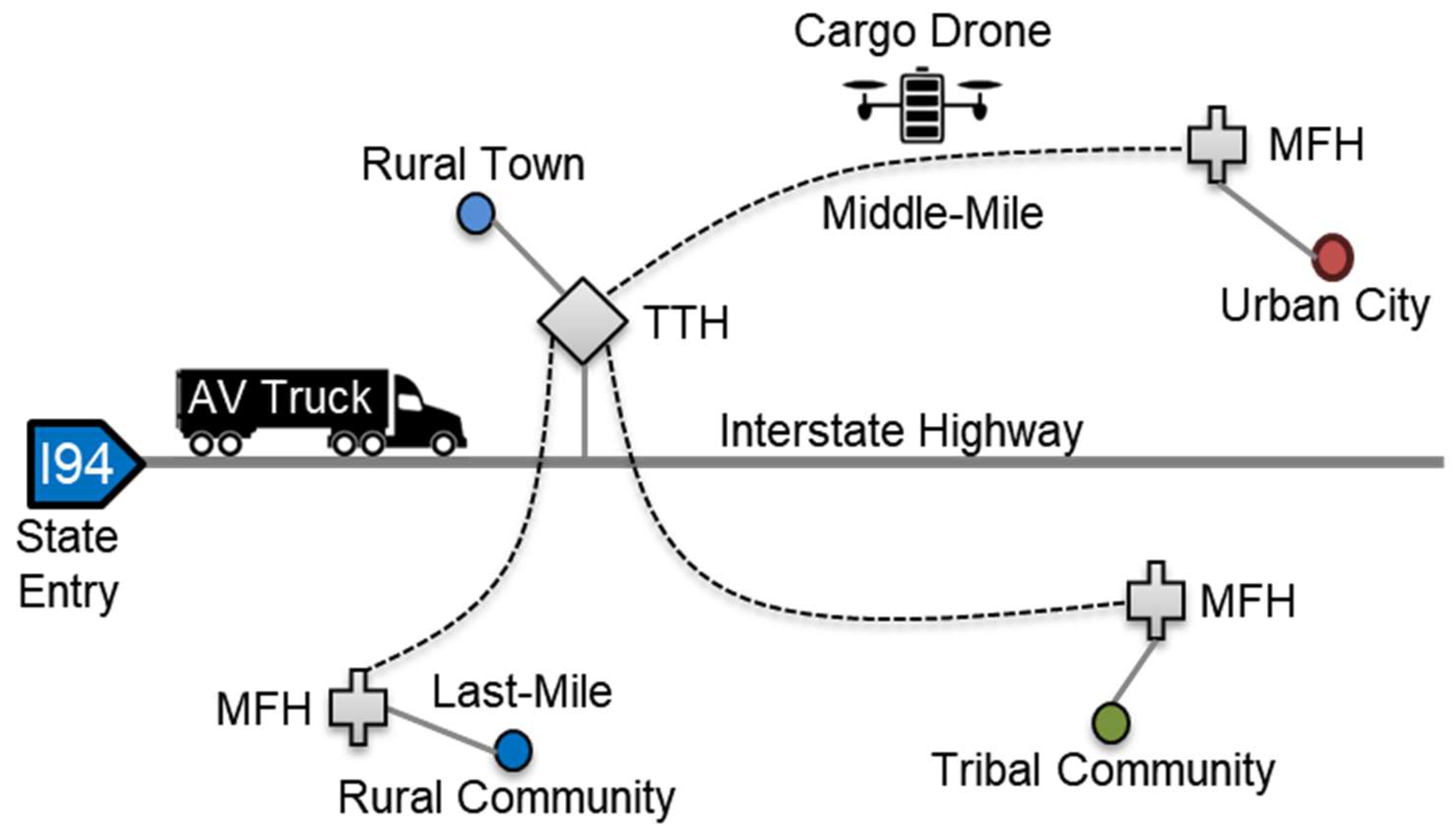
Figure 2.
Electronics arriving via air by a) value/weight and b) commodity rank by value/weight.
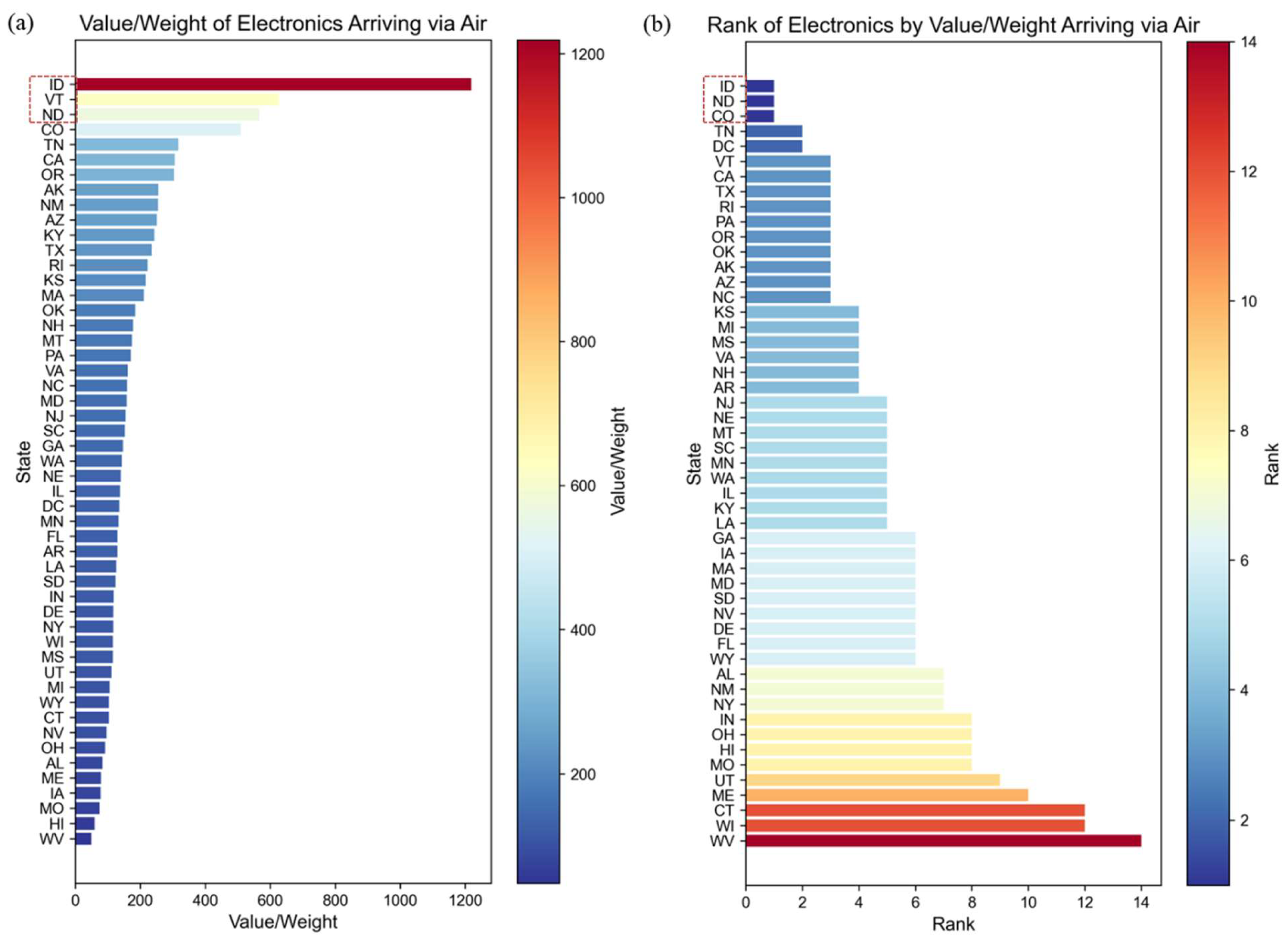
Figure 3.
Value-to-weight ratio of all commodities entering North Dakota by truck and air.
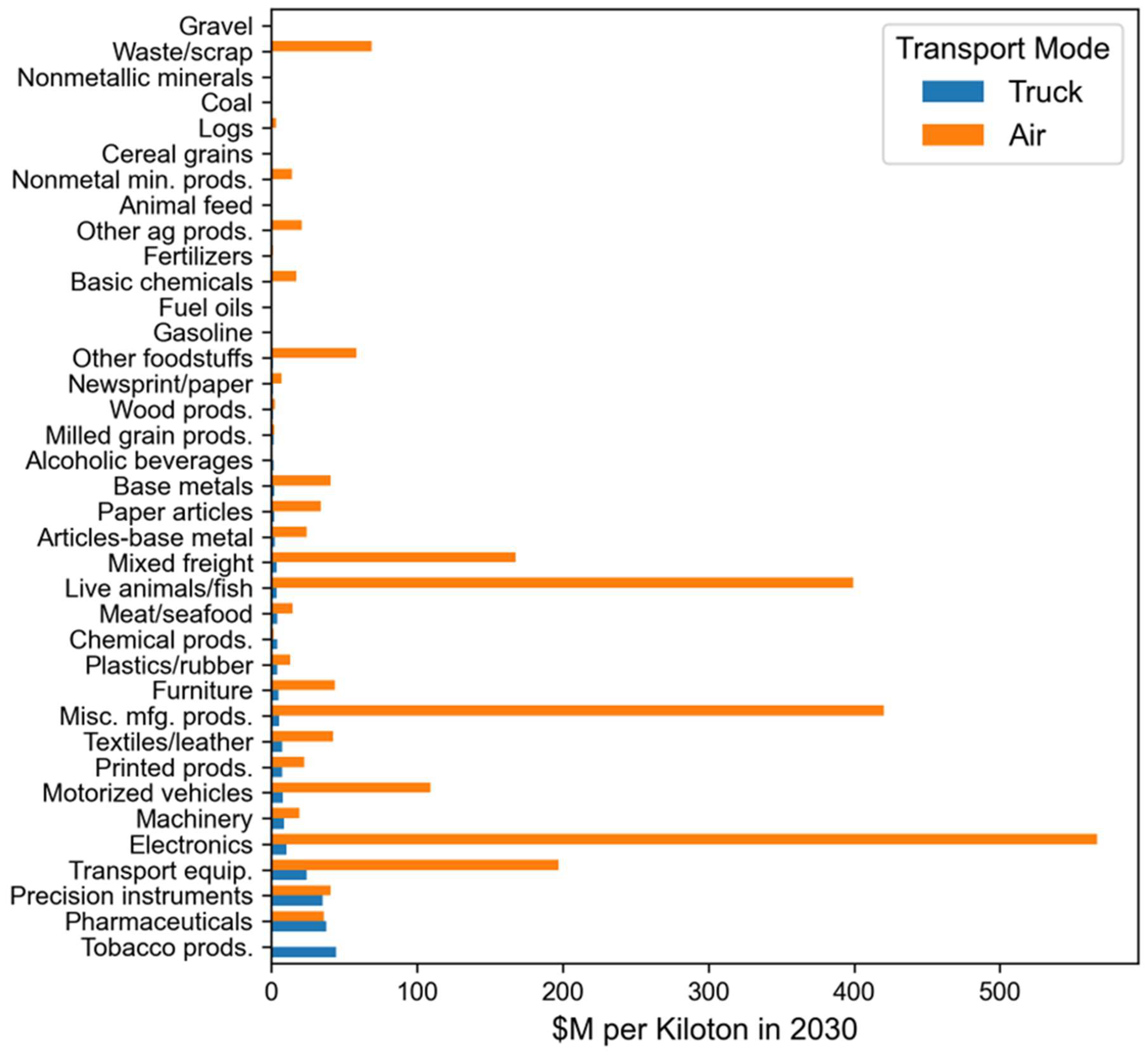
Figure 4.
Electronics forecasted to arrive in North Dakota via mode and a) weight and value, and b) value-to-weight ratio.
Figure 4.
Electronics forecasted to arrive in North Dakota via mode and a) weight and value, and b) value-to-weight ratio.
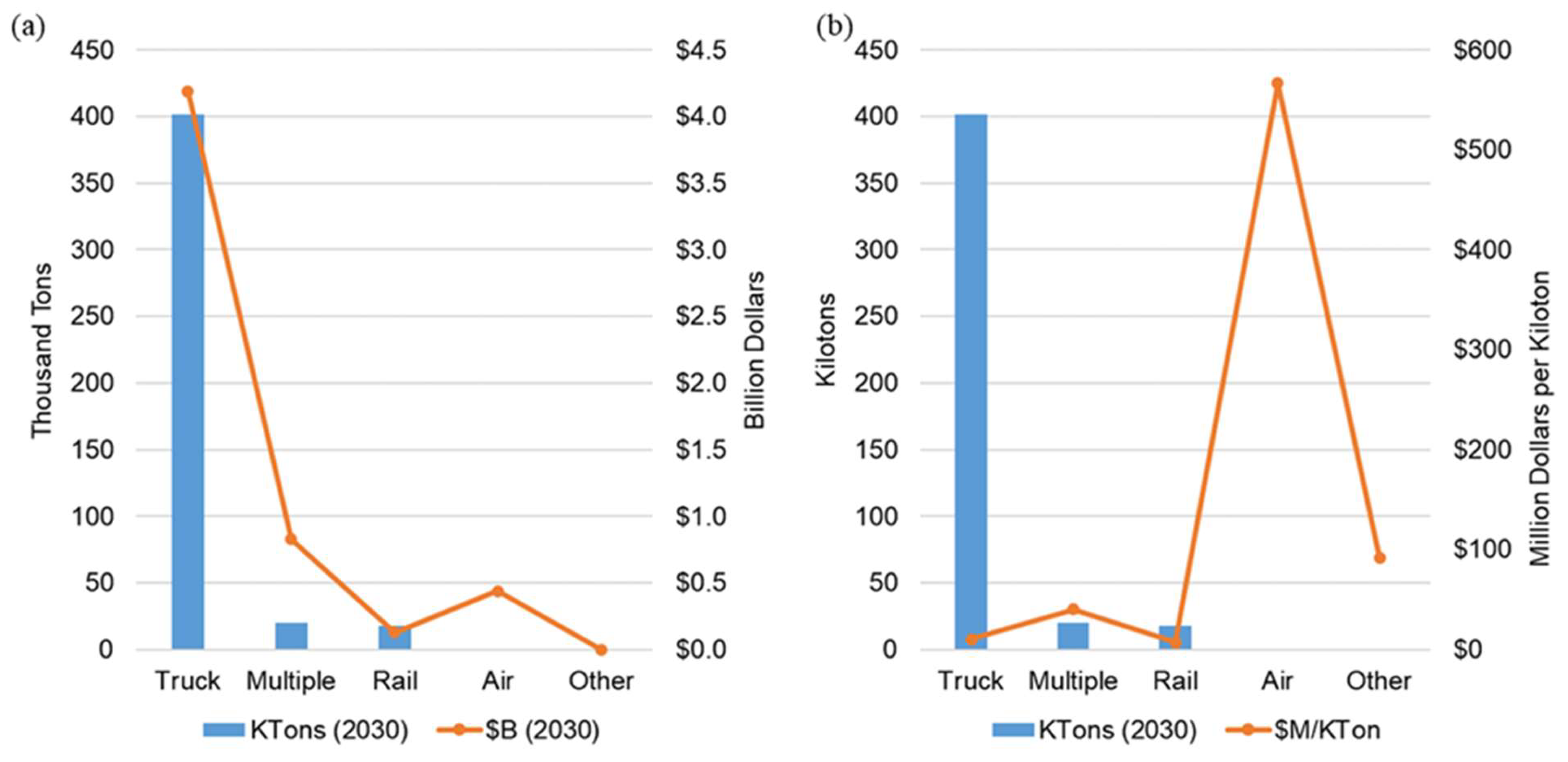
Figure 5.
The analytical workflow.
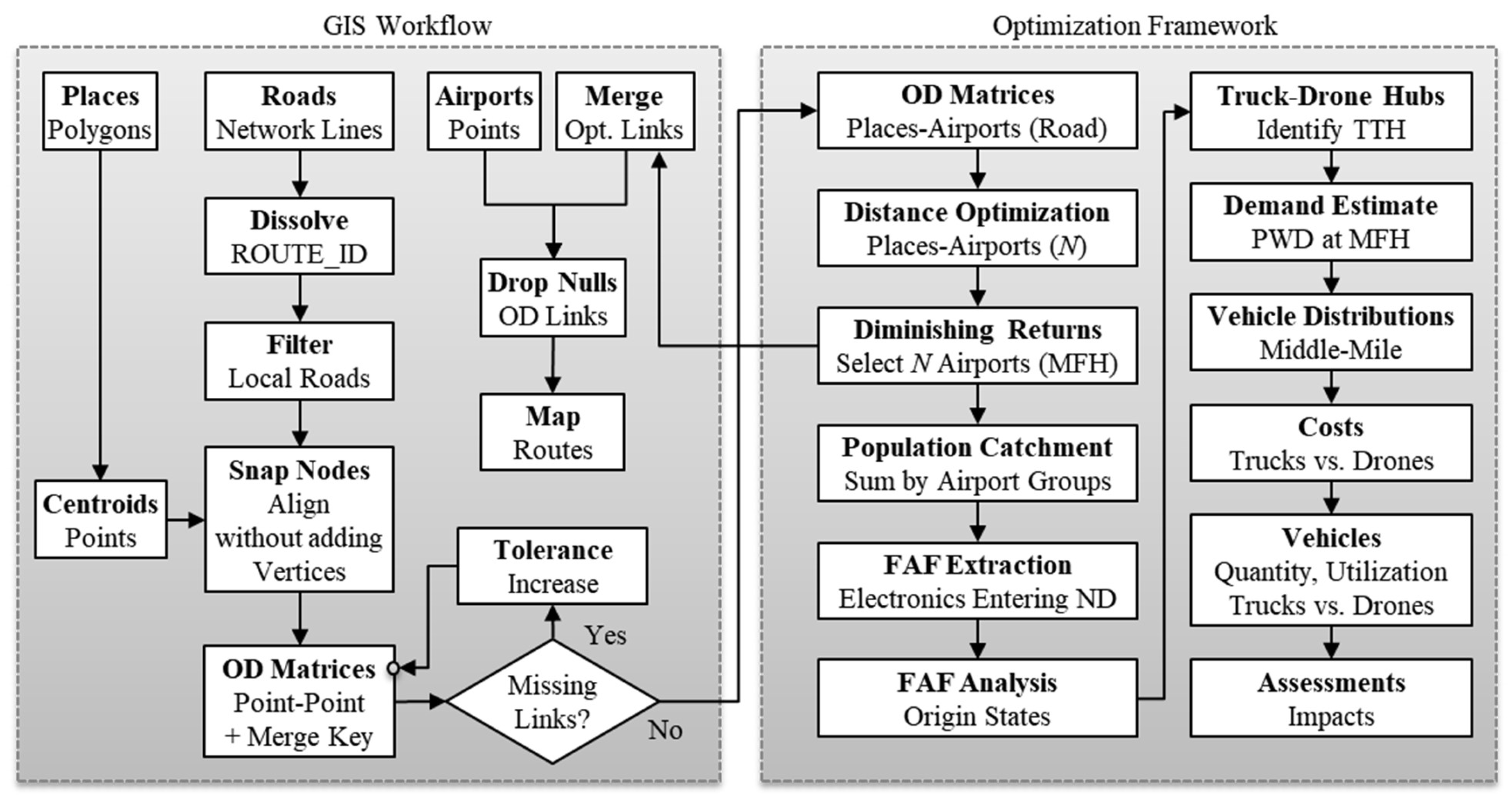
Figure 6.
Average drive distance as a function of the number of MFH selected.
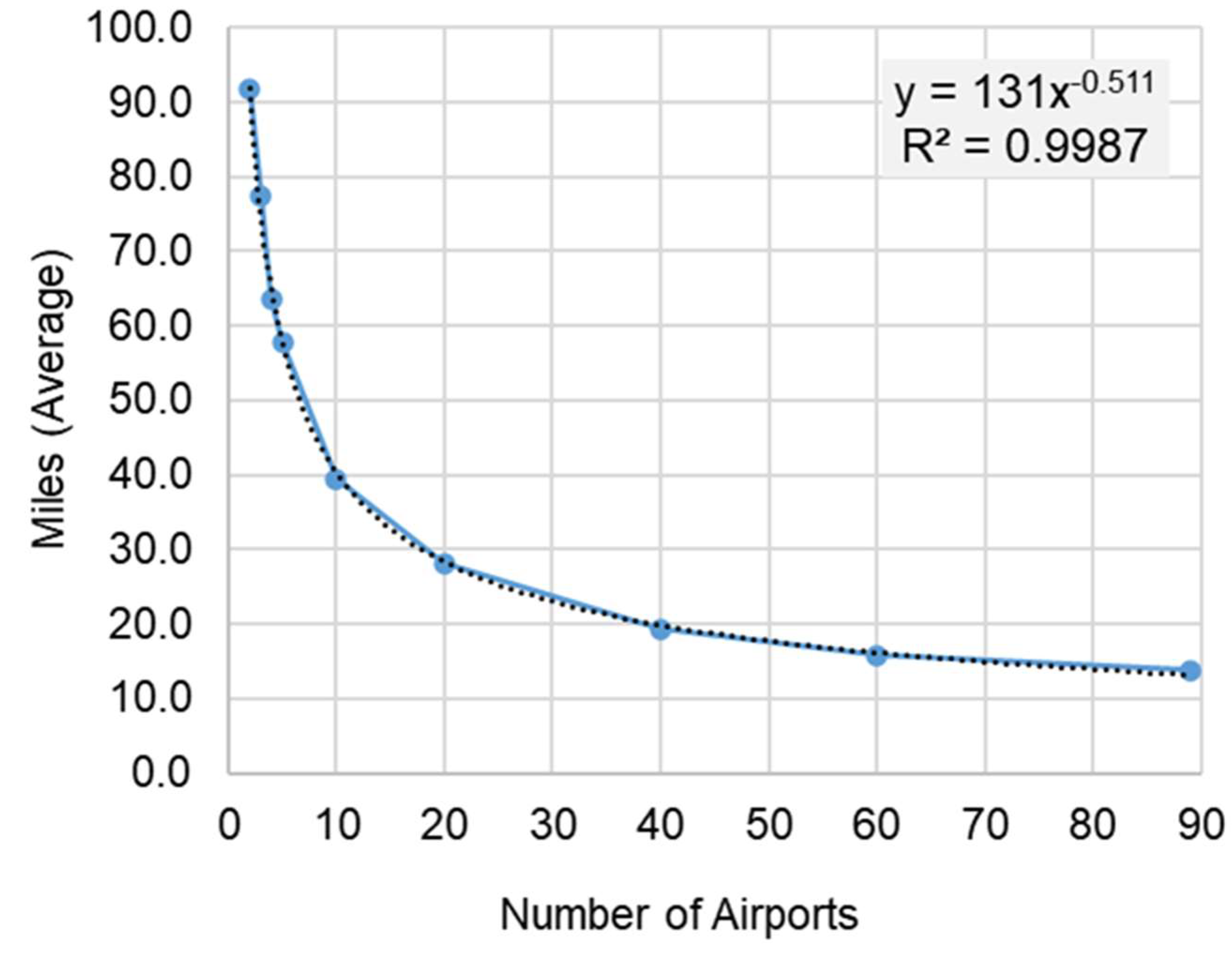
Figure 7.
Top ten origin state of electronics forecasted to arrive in North Dakota by truck.
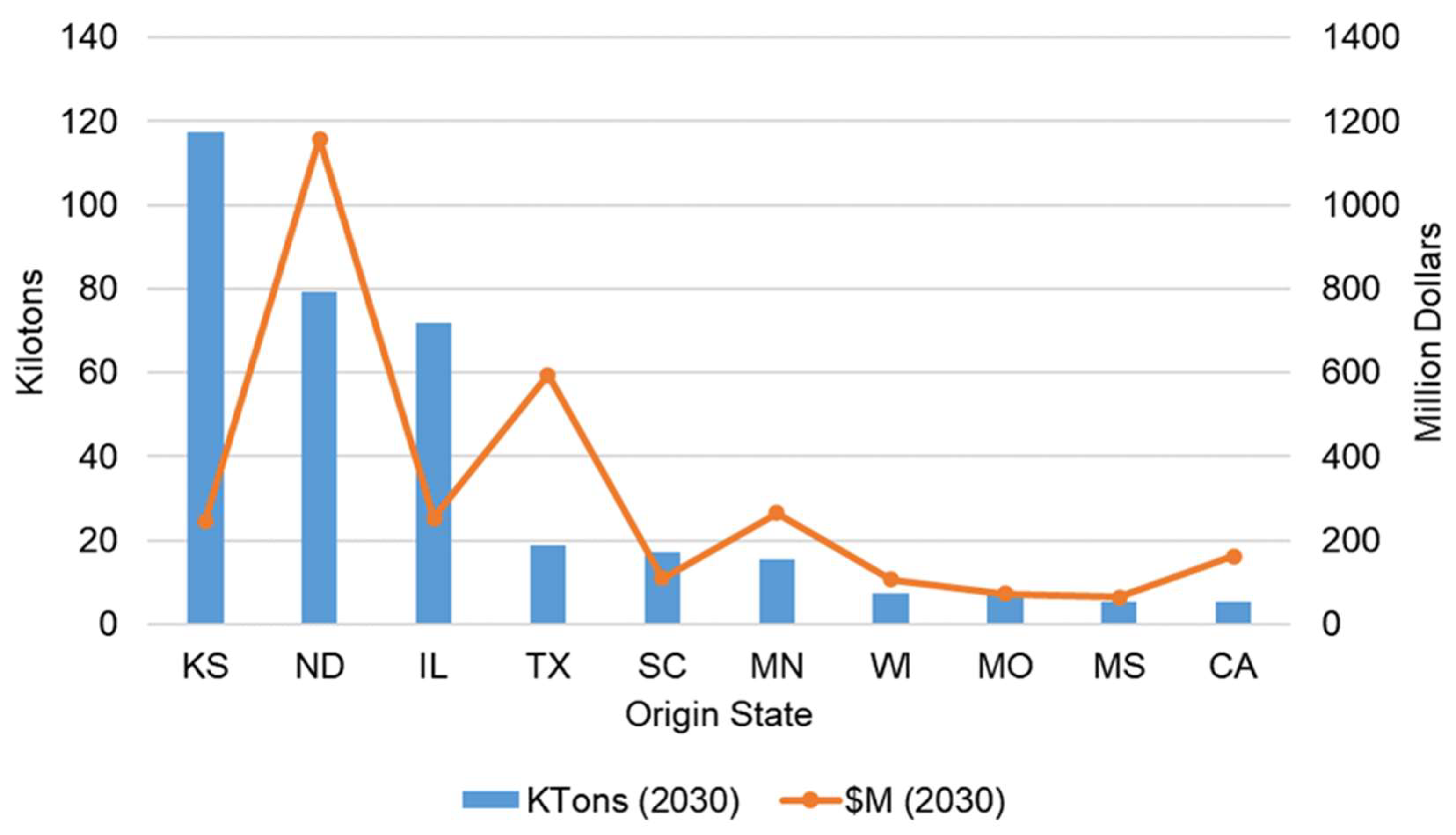
Figure 8.
Selected multimodal freight hubs and their population catchment.
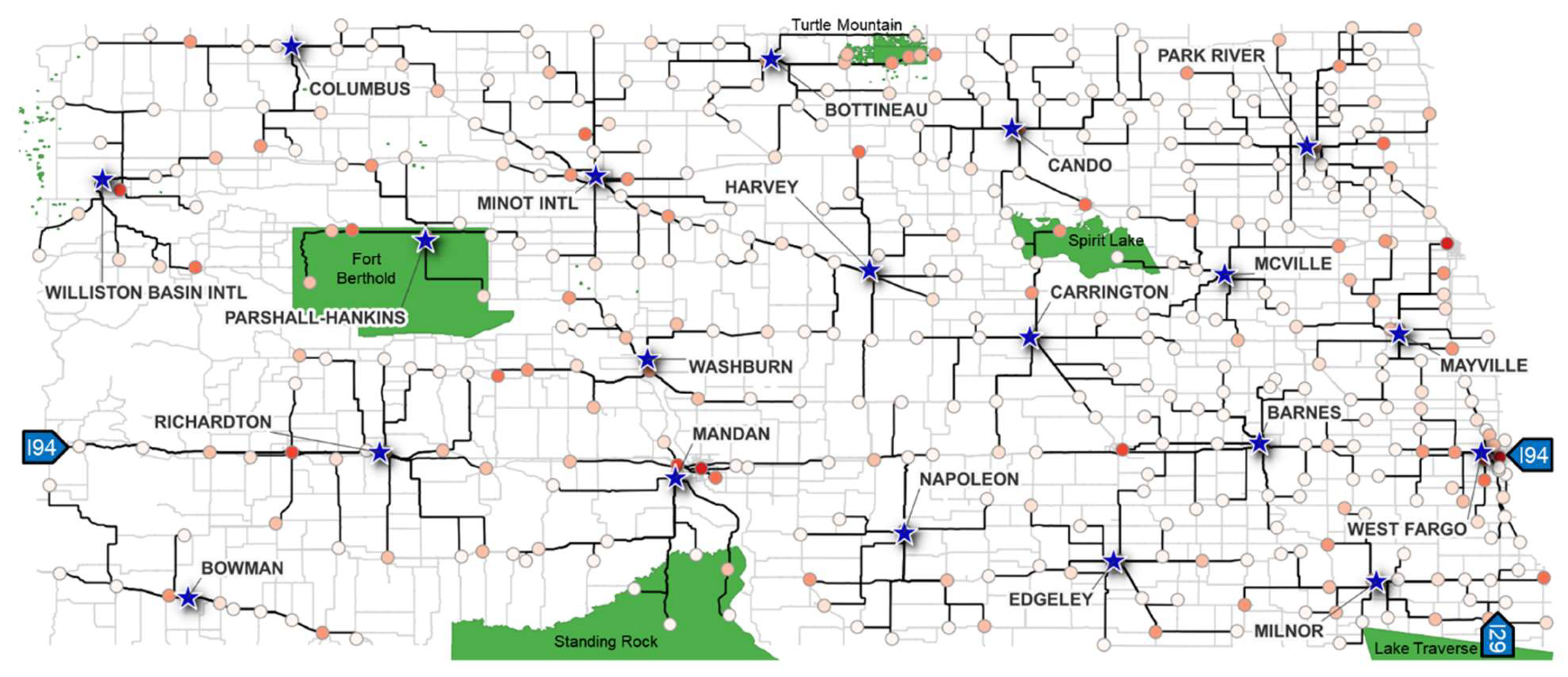
Figure 9.
Daily costs for trucks and drones transporting from TTHs at a) West Fargo and b) Richardton.
Figure 9.
Daily costs for trucks and drones transporting from TTHs at a) West Fargo and b) Richardton.
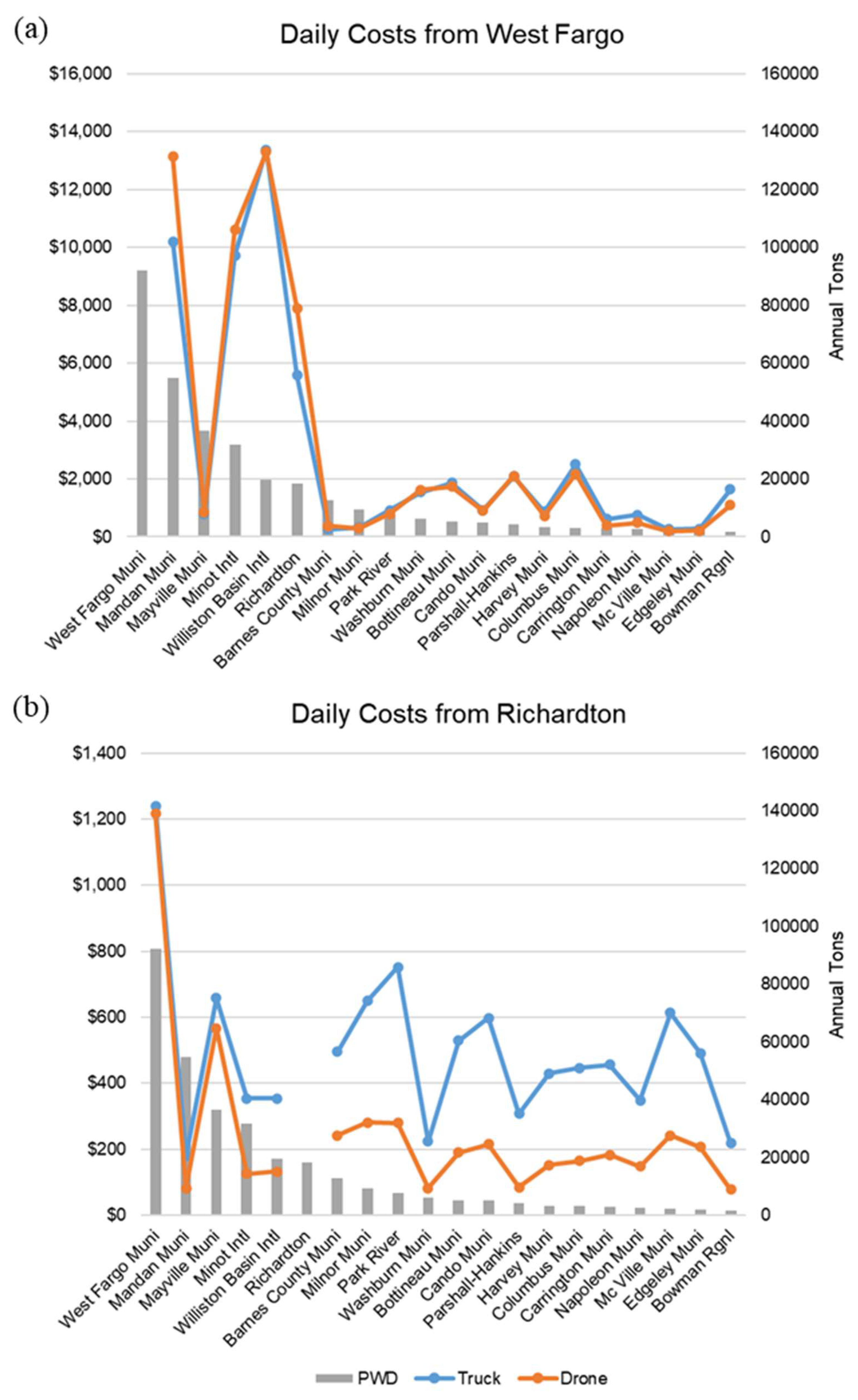
Figure 10.
Cost per ton for trucks and drones transporting from TTHs at a) West Fargo and b) Richardton.
Figure 10.
Cost per ton for trucks and drones transporting from TTHs at a) West Fargo and b) Richardton.
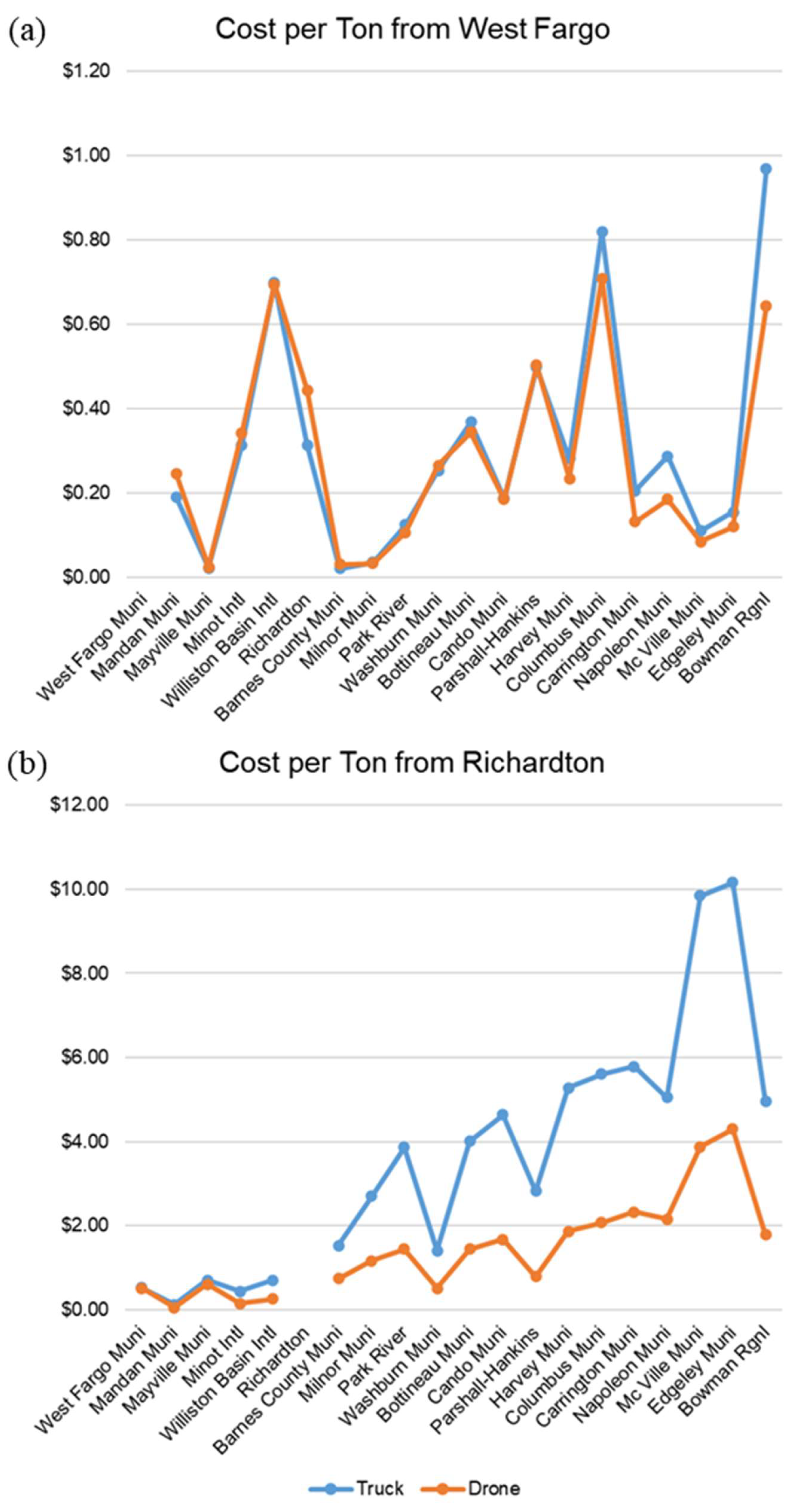
Figure 11.
Underutilization rates for trucks and drones transporting from TTHs at a) West Fargo and b) Richardton.
Figure 11.
Underutilization rates for trucks and drones transporting from TTHs at a) West Fargo and b) Richardton.
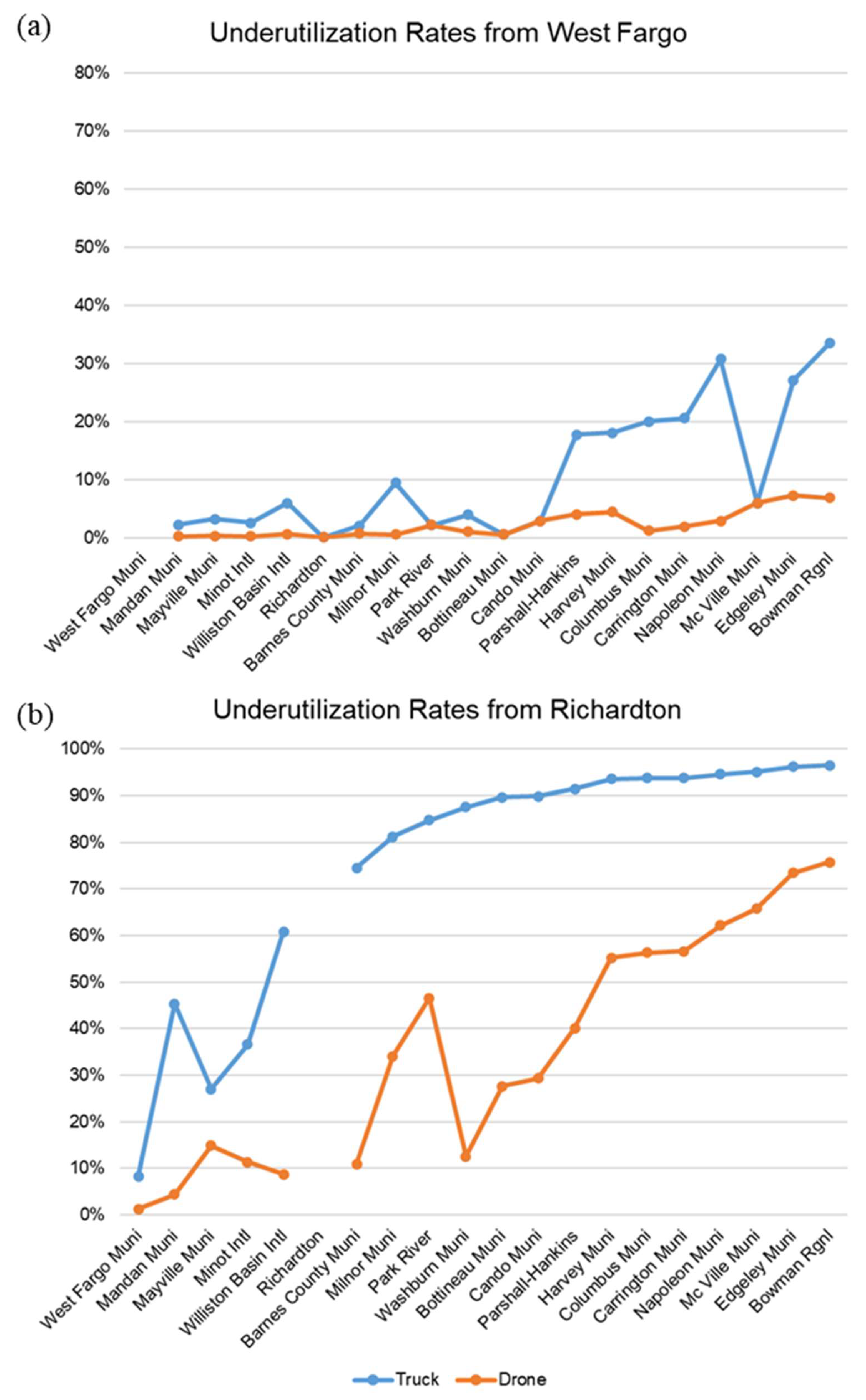
Table 1.
Data Utilized in this Study.
| Data | Description | Content | Source |
|---|---|---|---|
| Roads | Shapefile of lines representing ND road network geometry. | Extracted 349,585 road segments from the ND layer of the HPMS geodatabase containing layers of individual state road segments. | HPMS [29] |
| Airports | Shapefile of points representing U.S. airports. | Extracted 281 ND airports of 19,850 from the U.S. Department of Transportation (USDOT) Bureau of Transportation Statistics (BTS) dataset and selected 89 public use airports. | BTS [30] |
| Places | Shapefile of polygons representing populated places in the U.S. | Extracted 406 polygon representations of ND populated places from 31,616 in the ESRI USA Census Populated Places database. | ESRI [31] |
| Commodities | Weight and value of U.S. commodities transported. | Extracted data from 1.1 million records for pharmaceuticals imported to ND and exported from ND by trucks. | FAF 5.6 [32] |
| Truck Costs | The operational costs of traditional diesel trucking. | A longitudinal survey by the American Transportation Research Institute (ATRI) of trucking operational costs. | ATRI [33] |
Table 2.
Weight and Value by Origin State Region.
| Region | Kilotons | $M | Interstate |
| South | 222.7 | 1299.1 | I29 |
| East | 91.6 | 1506.9 | I94 |
| West | 226.3 | 226.3 | I94 |
Table 3.
Annual weight and value forecasted to arrive in ND.
| TTH | Tons | Dollars |
| West Fargo (TTH1) | 314,295.6 | $2,805,937,773 |
| Richardton (TTH2) | 8,178.0 | $226,317,192 |
| Total Demand | 322,473.6 | $3,032,254,965 |
Table 4.
Variables of the Analysis and Derivation.
| Variable | Description |
| PCT | Population catchment by truck routes. |
| TMA | Truck miles (average) to the population centers. |
| DMA | Drone miles (average) to the population centers. |
| PPT | Population catchment proportion of the state’s population. |
| PWD | Population weighted demand for electronics entering the state. |
| TTH1 | Annual tons of electronics to distribute from TTH 1 (West Fargo) to the MFHs |
| TTH2 | Annual tons of electronics to distribute from TTH 2 (Richardton) to the MFHs |
| TLD | Truck loads daily required |
| DLD | Drone loads daily required |
| TM | Truck miles between the TTH and the MFH |
| DM | Drone miles between the TTH and the MFH |
| TH | Truck hours between the TTH and the MFH |
| DH | Drone hours between the TTH and the MFH |
| TD | Truck dwell hours to refuel, load, and unload (1 hour). Based 200 mile recharge time. |
| DD | Drone dwell hours to charge, load, and unload (30 minutes) |
| TUH | |
| TPR | |
| TUU | |
| DUH | |
| DPR | |
| DUU | |
| TCM | Truck cost per mile (average USA) |
| DCM | Drone cost per mile to equal the total logistical cost of using trucks. |
| TC | |
| DC | |
| TCPT | , where x = {1, 2} |
| DCPT | , where x = {1, 2} |
Table 5.
Demand estimates at the selected MFH.
| MFH Location | PCT | TMA | DMA | PPT | PWD | TTH1 | TTH2 |
| West Fargo | 177380 | 17.9 | 14.3 | 28.6% | 92132.0 | 89795.6 | 2336.5 |
| Mandan | 105719 | 36.2 | 28.2 | 17.0% | 54911.0 | 53518.4 | 1392.5 |
| Mayville | 70562 | 24.2 | 18.8 | 11.4% | 36650.3 | 35720.8 | 929.5 |
| Minot | 61271 | 27.8 | 23.9 | 9.9% | 31824.5 | 31017.4 | 807.1 |
| Williston Basin | 37829 | 29.3 | 22.4 | 6.1% | 19648.6 | 19150.3 | 498.3 |
| Richardton | 35173 | 39.4 | 27.7 | 5.7% | 18269.0 | 17805.7 | 463.3 |
| Barnes County | 24617 | 27.0 | 20.5 | 4.0% | 12786.2 | 12461.9 | 324.3 |
| Milnor | 18223 | 26.4 | 22.4 | 2.9% | 9465.1 | 9225.1 | 240.0 |
| Park River | 14764 | 28.6 | 22.6 | 2.4% | 7668.5 | 7474.0 | 194.5 |
| Washburn | 12083 | 26.8 | 21.4 | 1.9% | 6276.0 | 6116.8 | 159.2 |
| Bottineau | 10004 | 27.7 | 22.3 | 1.6% | 5196.1 | 5064.4 | 131.8 |
| Cando | 9767 | 30.7 | 24.8 | 1.6% | 5073.0 | 4944.4 | 128.7 |
| Parshall-Hankins | 8275 | 27.5 | 20.9 | 1.3% | 4298.1 | 4189.1 | 109.0 |
| Harvey | 6180 | 27.2 | 21.5 | 1.0% | 3209.9 | 3128.5 | 81.4 |
| Columbus | 6035 | 29.3 | 22.4 | 1.0% | 3134.6 | 3055.1 | 79.5 |
| Carrington | 5992 | 28.6 | 23.9 | 1.0% | 3112.3 | 3033.3 | 78.9 |
| Napoleon | 5231 | 34.5 | 26.6 | 0.8% | 2717.0 | 2648.1 | 68.9 |
| McVille | 4732 | 23.7 | 18.6 | 0.8% | 2457.8 | 2395.5 | 62.3 |
| Edgeley | 3667 | 24.9 | 18.7 | 0.6% | 1904.7 | 1856.4 | 48.3 |
| Bowman | 3348 | 27.3 | 31.2 | 0.5% | 1739.0 | 1694.9 | 44.1 |
Table 6.
Truck and Drone Logistics for TTH1.
| MFH Location | TLD | DLD | TM | DM | TH | DH |
| West Fargo | N/A | N/A | N/A | N/A | N/A | N/A |
| Mandan | 42.01 | 294.1 | 198.1 | 188.7 | 5.0 | 1.9 |
| Mayville | 28.04 | 196.3 | 55.4 | 44.8 | 1.4 | 0.4 |
| Minot | 24.35 | 170.4 | 259.9 | 224.9 | 6.5 | 2.2 |
| Williston Basin | 15.03 | 105.2 | 381.2 | 331.4 | 9.5 | 3.3 |
| Richardton | 13.98 | 97.8 | 264.8 | 257.5 | 6.6 | 2.6 |
| Barnes County | 9.78 | 68.5 | 54.8 | 52.1 | 1.4 | 0.5 |
| Milnor | 7.24 | 50.7 | 69.0 | 50.5 | 1.7 | 0.5 |
| Park River | 5.87 | 41.1 | 131.7 | 111.6 | 3.3 | 1.1 |
| Washburn | 4.80 | 33.6 | 220.1 | 196.7 | 5.5 | 2.0 |
| Bottineau | 3.98 | 27.8 | 265.4 | 210.9 | 6.6 | 2.1 |
| Cando | 3.88 | 27.2 | 197.8 | 154.4 | 4.9 | 1.5 |
| Parshall-Hankins | 3.29 | 23.0 | 297.3 | 254.7 | 7.4 | 2.5 |
| Harvey | 2.46 | 17.2 | 187.4 | 154.9 | 4.7 | 1.5 |
| Columbus | 2.40 | 16.8 | 356.7 | 305.9 | 8.9 | 3.1 |
| Carrington | 2.38 | 16.7 | 133.0 | 112.2 | 3.3 | 1.1 |
| Napoleon | 2.08 | 14.6 | 162.2 | 138.2 | 4.1 | 1.4 |
| McVille | 1.88 | 13.2 | 111.7 | 84.9 | 2.8 | 0.8 |
| Edgeley | 1.46 | 10.2 | 122.1 | 94.0 | 3.1 | 0.9 |
| Bowman | 1.33 | 9.3 | 351.2 | 308.1 | 8.8 | 3.1 |
Table 7.
Truck and Drone Logistics for TTH2.
| MFH Location | TLD | DLD | TM | DM | TH | DH |
| West Fargo | 1.83 | 12.8 | 264.8 | 257.5 | 6.6 | 2.6 |
| Mandan | 1.09 | 7.7 | 76.5 | 69.8 | 1.9 | 0.7 |
| Mayville | 0.73 | 5.1 | 281.5 | 240.3 | 7.0 | 2.4 |
| Minot | 0.63 | 4.4 | 151.3 | 106.6 | 3.8 | 1.1 |
| Williston Basin | 0.39 | 2.7 | 151.3 | 112.9 | 3.8 | 1.1 |
| Richardton | 0.36 | 2.5 | 0.0 | 0.0 | 0.0 | 0.0 |
| Barnes County | 0.25 | 1.8 | 212.0 | 205.4 | 5.3 | 2.1 |
| Milnor | 0.19 | 1.3 | 278.1 | 238.4 | 7.0 | 2.4 |
| Park River | 0.15 | 1.1 | 321.4 | 237.6 | 8.0 | 2.4 |
| Washburn | 0.12 | 0.9 | 95.8 | 69.9 | 2.4 | 0.7 |
| Bottineau | 0.10 | 0.7 | 226.3 | 161.3 | 5.7 | 1.6 |
| Cando | 0.10 | 0.7 | 255.5 | 182.6 | 6.4 | 1.8 |
| Parshall-Hankins | 0.09 | 0.6 | 131.8 | 72.9 | 3.3 | 0.7 |
| Harvey | 0.06 | 0.4 | 183.7 | 129.4 | 4.6 | 1.3 |
| Columbus | 0.06 | 0.4 | 190.8 | 139.9 | 4.8 | 1.4 |
| Carrington | 0.06 | 0.4 | 195.2 | 156.0 | 4.9 | 1.6 |
| Napoleon | 0.05 | 0.4 | 148.9 | 126.0 | 3.7 | 1.3 |
| McVille | 0.05 | 0.3 | 262.1 | 204.9 | 6.6 | 2.0 |
| Edgeley | 0.04 | 0.3 | 209.8 | 176.3 | 5.2 | 1.8 |
| Bowman | 0.03 | 0.2 | 93.3 | 66.8 | 2.3 | 0.7 |
Table 8.
Truck and Drone Utilization and Costs for middle-mile transport from TTH1.
| MFH Location | TUH | TPR | TUU | DUH | DPR | DUU | TC | DC | TCPT | DCPT |
| West Fargo | N/A | N/A | N/A | N/A | N/A | N/A | N/A | N/A | N/A | N/A |
| Mandan | 511.9 | 22 | 2.3% | 1408.5 | 59 | 0.3% | $10,197.39 | $13,138.73 | $0.191 | $0.245 |
| Mayville | 138.3 | 6 | 3.3% | 373.3 | 16 | 0.4% | $777.57 | $844.89 | $0.022 | $0.024 |
| Minot | 374.8 | 16 | 2.6% | 940.1 | 40 | 0.3% | $9,729.75 | $10,614.42 | $0.314 | $0.342 |
| Williston Basin | 336.9 | 15 | 6.1% | 808.6 | 34 | 0.7% | $13,378.54 | $13,296.97 | $0.699 | $0.694 |
| Richardton | 213.4 | 9 | 0.2% | 602.6 | 26 | 0.2% | $5,577.27 | $7,898.89 | $0.313 | $0.444 |
| Barnes County | 47.4 | 2 | 2.2% | 140.9 | 6 | 0.8% | $256.56 | $369.04 | $0.021 | $0.030 |
| Milnor | 43.6 | 2 | 9.5% | 102.5 | 5 | 0.6% | $322.81 | $298.08 | $0.035 | $0.032 |
| Park River | 51.5 | 3 | 2.2% | 135.7 | 6 | 2.2% | $924.31 | $790.16 | $0.124 | $0.106 |
| Washburn | 65.0 | 3 | 4.0% | 167.7 | 7 | 1.2% | $1,544.95 | $1,624.55 | $0.253 | $0.266 |
| Bottineau | 61.1 | 3 | 0.6% | 146.1 | 7 | 0.6% | $1,862.89 | $1,742.39 | $0.368 | $0.344 |
| Cando | 47.6 | 2 | 3.0% | 114.4 | 5 | 3.0% | $925.49 | $910.78 | $0.187 | $0.184 |
| Parshall-Hankins | 67.5 | 3 | 17.8% | 146.2 | 7 | 4.1% | $2,087.19 | $2,103.70 | $0.498 | $0.502 |
| Harvey | 34.1 | 2 | 18.1% | 73.8 | 4 | 4.5% | $877.09 | $731.17 | $0.280 | $0.234 |
| Columbus | 59.5 | 3 | 20.1% | 121.0 | 6 | 1.3% | $2,503.99 | $2,165.65 | $0.820 | $0.709 |
| Carrington | 26.0 | 2 | 20.6% | 55.1 | 3 | 2.0% | $622.66 | $397.07 | $0.205 | $0.131 |
| Napoleon | 30.3 | 2 | 30.7% | 56.5 | 3 | 3.0% | $758.96 | $489.28 | $0.287 | $0.185 |
| McVille | 15.2 | 1 | 6.0% | 37.8 | 2 | 6.0% | $261.36 | $200.47 | $0.109 | $0.084 |
| Edgeley | 16.2 | 1 | 27.1% | 31.7 | 2 | 7.3% | $285.82 | $221.92 | $0.154 | $0.120 |
| Bowman | 39.1 | 2 | 33.5% | 71.6 | 3 | 6.9% | $1,643.59 | $1,090.68 | $0.970 | $0.644 |
Table 9.
Truck and Drone Utilization and Costs for middle-mile transport from TTH2.
| MFH Location | TUH | TPR | TUU | DUH | DPR | DUU | TC | DC | TCPT | DCPT |
| West Fargo | 30.5 | 4 | 8.3% | 79.9 | 4 | 1.2% | $1,239.39 | $1,215.21 | $0.530 | $0.520 |
| Mandan | 11.6 | 1 | 45.3% | 19.2 | 1 | 4.4% | $178.94 | $82.41 | $0.128 | $0.059 |
| Mayville | 16.1 | 2 | 27.0% | 34.8 | 2 | 14.9% | $658.63 | $567.14 | $0.709 | $0.610 |
| Minot | 9.6 | 1 | 36.7% | 15.7 | 1 | 11.3% | $353.99 | $125.74 | $0.439 | $0.156 |
| Williston Basin | 9.6 | 1 | 60.9% | 9.8 | 1 | 8.7% | $354.09 | $133.23 | $0.711 | $0.267 |
| Richardton | N/A | N/A | N/A | N/A | N/A | N/A | N/A | N/A | N/A | N/A |
| Barnes County | 12.6 | 1 | 74.5% | 10.2 | 1 | 10.9% | $496.07 | $242.33 | $1.530 | $0.747 |
| Milnor | 15.9 | 1 | 81.2% | 11.5 | 1 | 34.1% | $650.67 | $281.27 | $2.711 | $1.172 |
| Park River | 18.1 | 1 | 84.7% | 11.5 | 1 | 46.6% | $751.99 | $280.38 | $3.867 | $1.442 |
| Washburn | 6.8 | 1 | 87.5% | 2.4 | 1 | 12.5% | $224.17 | $82.51 | $1.408 | $0.518 |
| Bottineau | 13.3 | 1 | 89.7% | 4.2 | 1 | 27.6% | $529.46 | $190.34 | $4.018 | $1.444 |
| Cando | 14.8 | 1 | 89.9% | 4.7 | 1 | 29.3% | $597.87 | $215.42 | $4.647 | $1.674 |
| Parshall-Hankins | 8.6 | 1 | 91.4% | 2.5 | 1 | 40.1% | $308.41 | $86.07 | $2.829 | $0.790 |
| Harvey | 11.2 | 1 | 93.6% | 3.6 | 1 | 55.3% | $429.79 | $152.64 | $5.280 | $1.875 |
| Columbus | 11.5 | 1 | 93.8% | 3.8 | 1 | 56.3% | $446.41 | $165.06 | $5.616 | $2.076 |
| Carrington | 11.8 | 1 | 93.8% | 4.1 | 1 | 56.6% | $456.71 | $184.07 | $5.786 | $2.332 |
| Napoleon | 9.4 | 1 | 94.6% | 3.5 | 1 | 62.1% | $348.33 | $148.68 | $5.055 | $2.158 |
| McVille | 15.1 | 1 | 95.1% | 5.1 | 1 | 65.8% | $613.30 | $241.81 | $9.839 | $3.880 |
| Edgeley | 12.5 | 1 | 96.2% | 4.5 | 1 | 73.5% | $491.03 | $208.00 | $10.166 | $4.306 |
| Bowman | 6.7 | 1 | 96.5% | 2.3 | 1 | 75.8% | $218.37 | $78.80 | $4.952 | $1.787 |
Disclaimer/Publisher’s Note: The statements, opinions and data contained in all publications are solely those of the individual author(s) and contributor(s) and not of MDPI and/or the editor(s). MDPI and/or the editor(s) disclaim responsibility for any injury to people or property resulting from any ideas, methods, instructions or products referred to in the content. |
© 2024 by the author. Licensee MDPI, Basel, Switzerland. This article is an open access article distributed under the terms and conditions of the Creative Commons Attribution (CC BY) license (http://creativecommons.org/licenses/by/4.0/).
Copyright: This open access article is published under a Creative Commons CC BY 4.0 license, which permit the free download, distribution, and reuse, provided that the author and preprint are cited in any reuse.
MDPI Initiatives
Important Links
© 2024 MDPI (Basel, Switzerland) unless otherwise stated






